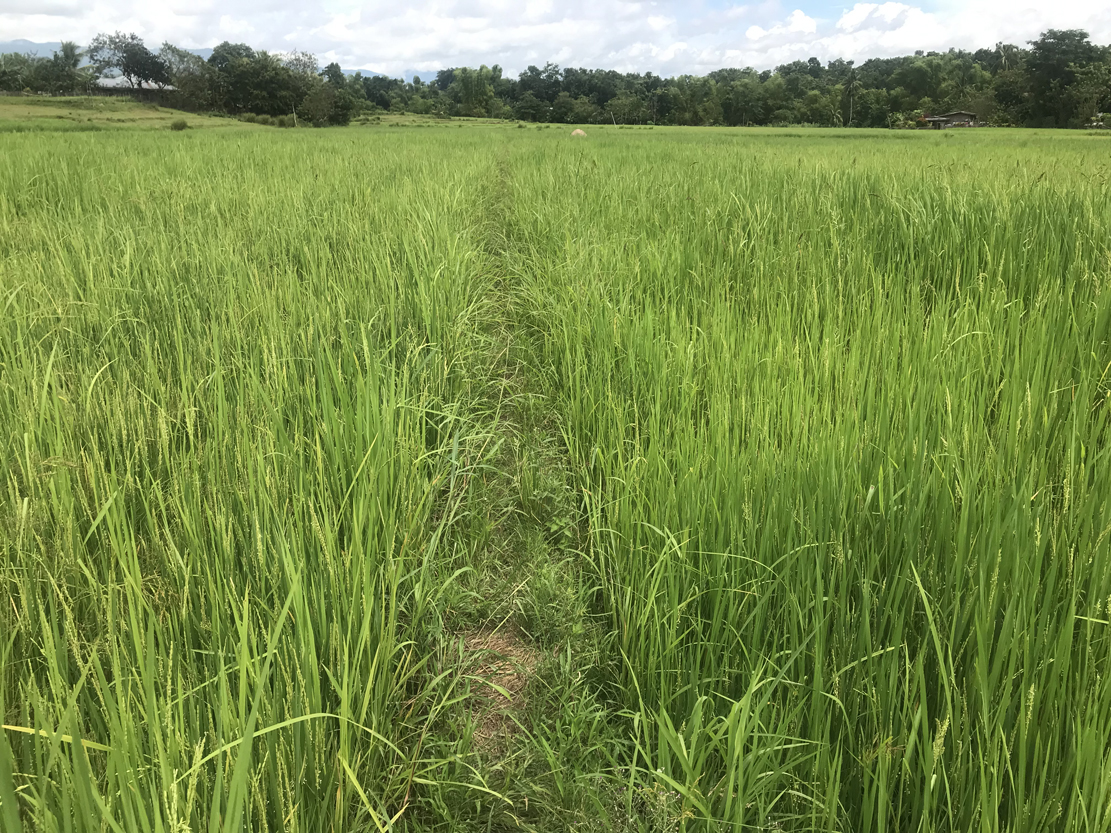PROPRIETARY METHOD USING MICROBEBIO® MICROBIAL AND ORGANIC NUTRIENTS FOR THE RICE PRODUCTIVITY
I. RICE PLANT GROWTH STAGES
There are tons of rice varieties in the market that the farmers should have different methods for growing rice plants. Therefore, the identification of the rice plant growth stages will help the farmers to prepare a reasonable plan for each season.
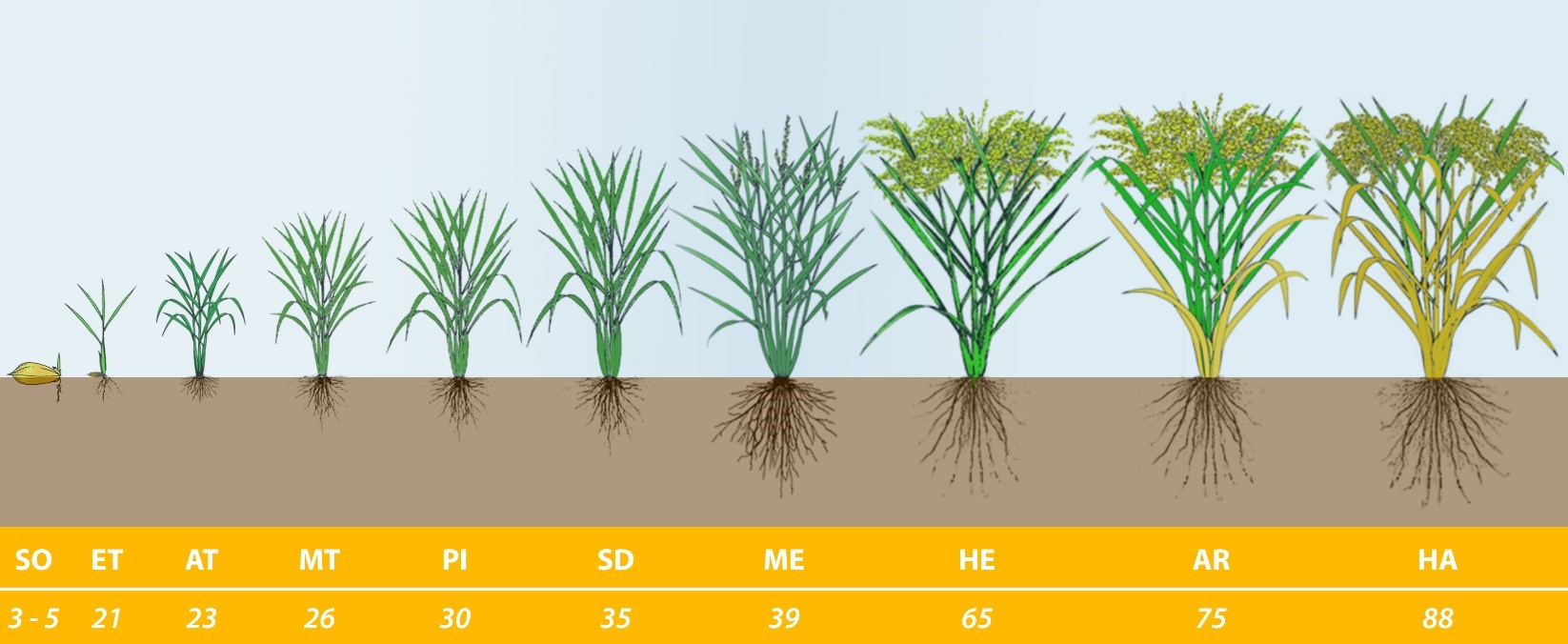
| GROWTH STAGES | BBCH SCALES | IDENTIFICATION | CONVENTIONAL SIGNAL | LEAF POSITION | |
| Germination | 05 | Emergence of coleoptile | 80% | SO | |
| Transplanting | 13 | The emergence of Therprophyll from coleoptile | 80% | TR | |
| Emergence tillering | 21 | Collar formation on Leaf 3 on the main stem | 50% | ET | |
| Pre-tillering | 23 | Collar formation on Leaf 6 on the main stem | 50% | AT | |
| Tillering | 26 | Collar formation on Leaf 13 (flag leaf) on the main stem | 50% | MT | |
| Panicle Initiation | 30 | Panicle development has initiated | 50% | PI | 4th leaf |
| Anthesis (flowering) | 32 | Panicle exertion from a boot, a tip of panicle is above the collar of flag leaf | 50% | PF | 3rd leaf |
| Ripening | 35 | At least one caryopsis on the main stem panicle has elongated to the end of the hull | 50% | SD | 2nd leaf |
| Milk stage and soft dough stage | 39 | At least one caryopsis on the main stem panicle is elongating to the end of the hull | 50% | ME | Flag leaf |
| Hard dough stage | 58 | At least one grain on the main stem panicle has a yellow hull | 80% | HE | |
| Maturity | 75 | At least one grain on the main stem panicle has a brown hull | 50% | AR | |
| Harvest | 88 | All grains which reached R6 have a brown hull | 80% | HA | |
The critical rice plant growth stages:
- Germination: Nutrition from the endosperm can supply the growing embryo for about 3 weeks (~20 days). In the embryo, two primary structures grow and elongate the radicle (first root) and coleoptile (protective covering enveloping the shoot). As the radicle and coleoptile grow, they apply pressure to the inside of the hull. Eventually, the hull weakens under the pressure, and the pointed, slender radicle and coleoptile emerge. The appearance of the radicle and coleoptile loosely defines the completion of germination
- Vegetative Phase: Seedling development begins when the primary leaf appears shortly after the coleoptile is exposed to light and splits open at the end. The primary leaf elongates through and above the coleoptile. The primary leaf is not a typical leaf blade and is usually 1 inch or less in length. The primary leaf acts as a protective covering for the next developing leaf. As the seedling grows, the next leaf elongates through and past the tip of the primary leaf. Continuing to grow and develop, the leaf differentiates into three distinct : arts: the sheath, collar, and blade.
- Reproductive Phase: The remaining leaves of the plant develop, internode elongation and stem formation continue, and panicle formation begins. When cells first begin actively dividing between the growing point or apical meristem, the process is called panicle initiation (PI).
- Maturity: Maturity occurs when carbohydrate is no longer translocated to the panicle. At this time, the endosperm of all grains on the panicle of the main stem is firm. Most grains are some shade of brown and the grains in the lower quarter of the panicle are the only ones with a greenish tint.
II. MICROBEBIO™ PRODUCTS ARE YOUR CHOICE:
Deep down within the soil, there are a whole bunch of essential microbes that consists of fungi and bacteria. These microbes play a vital role in the overall development and growth of your rice plant.
Having said that, the idea of bacteria aiding nutrition to the rice plants might seem strange to you. But do remember that the human body also contains several bacteria to keep it healthy. Of course, humans are not made of soil. Therefore, things do not exactly work in the same fashion. But the microbes in our guts and those found in the soil share key common functions.
Essential microbes in the soil help in breaking down the available nutrients. This breakdown of substances helps the rice plant roots to increase their uptake of beneficial nutrients more efficiently.
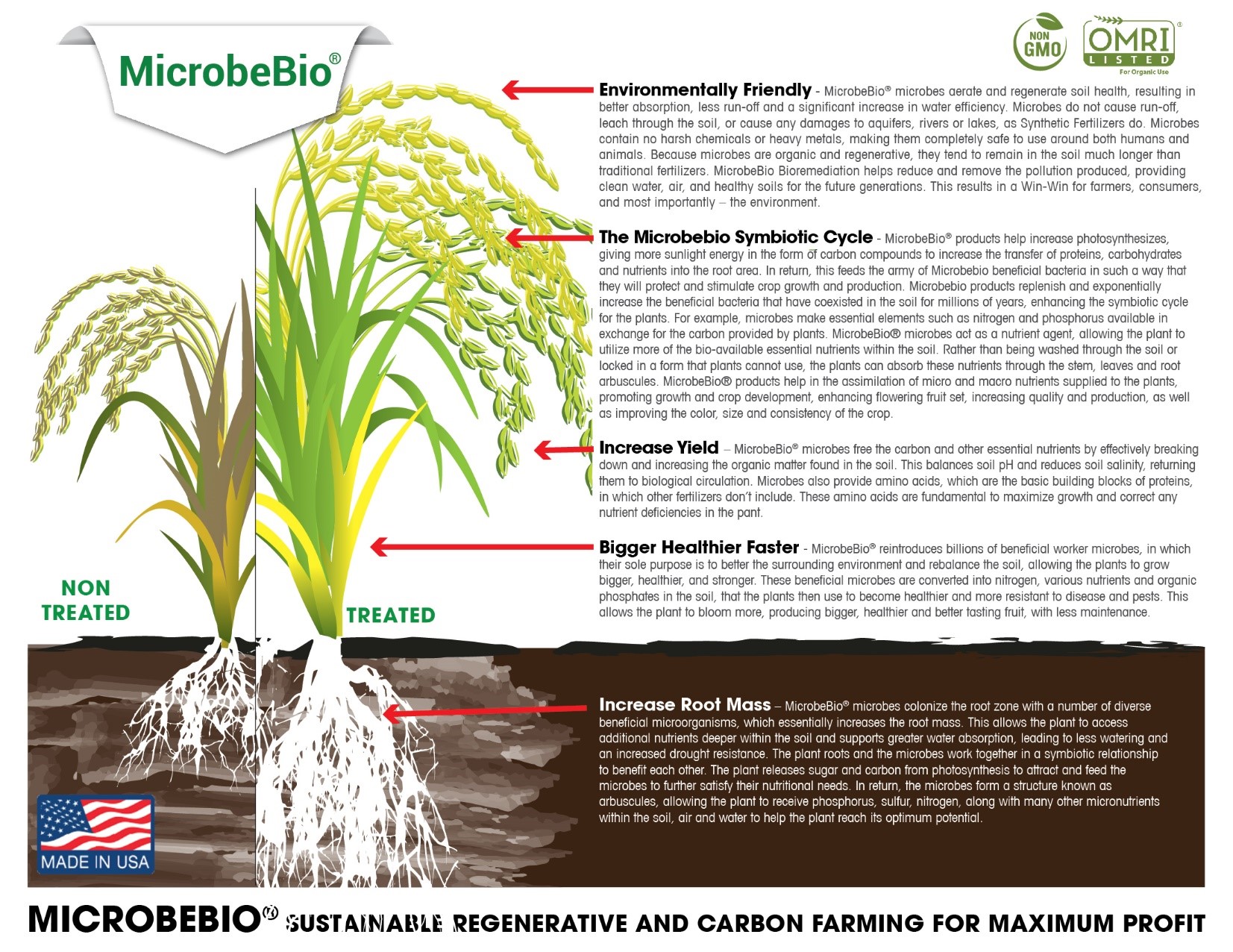
III. GROWING METHODS
RAISING NURSERY:
Step 1: Choose the area
For optimal results, most of the care should be done in the preparation of the nursery bed, as 8 – 12 days old seedling and in some places 14 – 15 days old seedlings (2 – 3 leaf stage) are transplants. The nursery bed should be preferably prepared in the center or corner of the plot for quick or efficient transplanting.
Step 2: Plan the size of the bed
For one 1 hectare transplantation, the nursery bed can be raised into 2 beds. Each of the beds should be in a 40 square meter (m2) plot per 2 kg seeds. It is depending upon the area, so the method may be different.
A bed with a width of 125 – 130 cm. The length of the bed can be decided by the farmers depending on the ground situation. As roots of 8 – 10 days old the seedling grow up to 3 inches (7.5 cm), it is necessary to prepare raised beds of 5 – 6 inches ( 12.5 – 15 cm). To drain excess water, appropriate channels should be shown on all sides by making drainage cum irrigation channels (0.5 – 1 foot width). To prevent soil erosion, the bed on all sides should be made secure with wooden reapers, planks. paddy straw, or other tools that the farmers normally use.
Step 3: Bed preparation
The nursery bad is prepared with the application of the method and the soil in 4 alternation layers:
- 1st layer: 1 inch (2.54 cm) thick well-decomposed method
- 2nd layer: 1.5 inches (3.75 cm) soil.
- 3rd layer: 1 inch (2.54 cm) thick well-decomposed method.
- 4th layer: 2.5 inches (6.3 cm) soil.
All these layers should be mixed well as it will help in easy penetration of roots. Besides compost or vermicompost can also be used and spread them over all the bed in 3 – 5 cm layer.
GERMINATION:
Step 1: Sunbathing of the seed (exposure of the seed to sunlight) should be done at least one or two days before seed dipping. Most of the time, the seed rate will be at least 5 kg/ha. Seeds should be thinly spread to avoid the crowding of seedlings. Make sure there are no two seeds that touch each other.
Step 2: The size of the seed is highly correlated to the growth of young plants. The sprouts and roots of unhealthy seeds do not develop well and die easily, even from minor changes in temperature and conditions. One needs to select large and solid seeds, endowed with sufficient carbohydrates (energy) and nutrients for healthy plants. Eliminate spoiled (deformed, light, or small) seeds and select only solid, robust ones. This will make the quality of seeds even and will result in more regular germination and healthier growth of plants. The sorting method recommended is as follows:
- Sort the seeds using wind or screen in combination with sunning to eliminate any empty or small grains and foreign substances.
- After placing the seeds in a bowl with clean water, shake them softly to remove any empty grains or foreign substances
Step 3: Soaking.
Many varieties have a dormancy period where germination levels are low. Several treatments can be used to break dormancy and improve seed growth. Note: Pre-germinated seeds cannot be sown through a drill seeder.
- Expose seeds to high temperatures (40−42°C) for 1−2 days before sowing.
- Seed priming – Soak seeds for 4−8 hours and re-dry before sowing. Seeds must be sown within 1−2 days after priming.
- Pre-germination – Submerge seeds in water for 12−24 hours or until small shoots appear at the end of the seed. In colder weather, seeds may need to be soaked for 36−48 hours. Drain and dry the seed in the bag for 24 hours in a shady area where air can circulate the bags. If bag temperatures exceed 42°C, some seeds will be damaged. Broadcast or drum seed before the roots exceed 5mm in length. When calculating the planting rate, allow for an expansion of 10-30% in seed weight.
Step 4: Sprouting.
Suggest soaking the sprouts with MicrobeBio® products that contain 100% organic nutrient-rich ingredients infused with value-added biologicals performed to be effective for the prevention and suppression of soil-borne such as nematodes and fungi.
Note: Please gently mix or blend the sprouts to limit the new roots broken from a coleoptile.
MicrobeBio® Nature Vigor™ – Apply 100g to soak or spray to the seeding.
HOW IT WORKS
- The microbes adhere to the epidermis of the roots, forming a mutualistic relationship with the plant. The microbes feed off the secretes of the plant and distribute nitrogen daily throughout its growth cycle.
- The most effective action for this application is Trichoderma sp. during the rooting phase results in greater shoot lengths, as well as increased numbers of leaves, roots, stem diameters and promotes plant growth by both direct and indirect functions.
- The product provides nutrient-rich ingredients infuse with value-added biologicals performed to be effective for the prevention of the fungi.
MICROBEBIO® NATURE VIGOR™
Introduction:
MicrobeBio® Nature Vigor™ contains a synergistic consortium of naturally occurring probiotic soil microbes, macro/micronutrients, and organic matter designed to enhance virtually all crop types, soil conditions, and climates. It contains a natural rhizosphere bacterium that quickly populates the soil, forming protective colonies around delicate root hairs and on the leaf surface. Each gram-positive bacterium in this product, which survives in extreme environmental conditions including heat and drought, salinity, and extreme pH making it a durable, reliable, and effective reduction and prevention of soil-borne and foliar fungal and bacterial diseases.
The product better protects plants against pathogenic plant fungi such as Fusarium oxysporum f.sp. lycopersici; Fusarium oxysporum f.sp. cubense; Fusarium oxysporum f.sp. dianthi; Rhizoctonia solani; Sclerotium rolfsii; Sclerotinia sclerotiorum; Pythium ultimum; Phytophthora infestans; and P. nicotianae
Notice: MicrobeBio® Nature Vigor™ is mingled with special proprietary microorganisms to reduce the fungi (at roots), so the product does not knockdown or control instant results as other chemical products in the market.
Benefits:
- Boost crop yields
- Reduce adverse environmental impacts
- Boost drought resistance
- Heal and protect soil
- Boost root vitality
- Boost seed germination
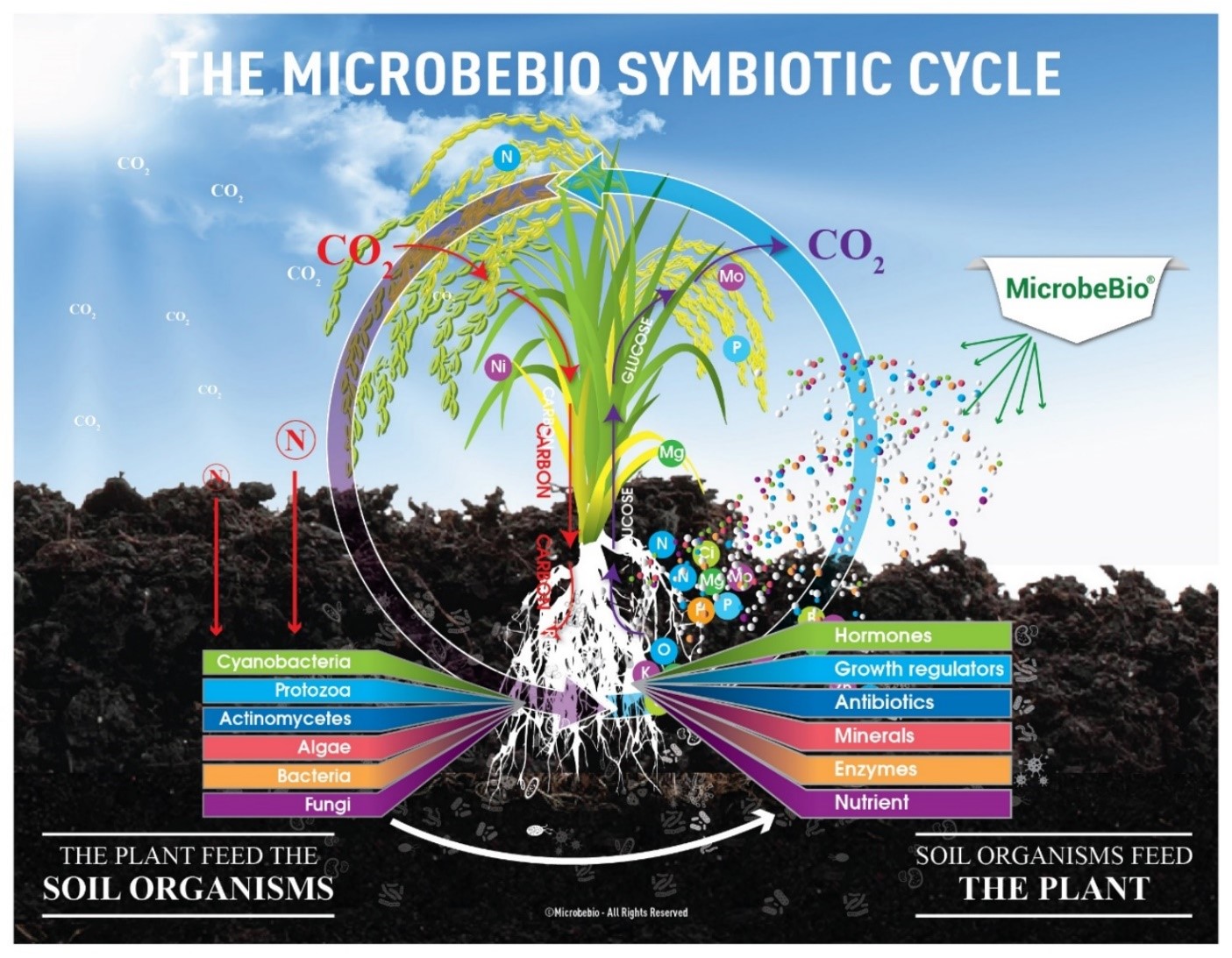
Nutrients from the product:
- Nitrogen is a component of many important organic compounds ranging from proteins to nucleic acids. The primary nutrient helps plant growing stronger and against plant pathogens.
- Phosphorus plays a central role in plants with energy transfer and protein metabolism against harmful fungi.
- Potassium helps in osmotic and ionic regulation. Potassium functions as a cofactor or activator for many enzymes of carbohydrate and protein metabolism that prevent parasitize all of the reproductive stages of plant pathogenic nematodes.
- Calcium is involved in cell division and plays a major role in the maintenance of membrane integrity. This is a vital element that helps plants grow and develop.
- Magnesium is known as a component of chlorophyll and a cofactor for many enzymatic reactions. The process will create the best protection on the leaf surface where the harmful pests or fungi hard to latch on.
- Sulfur is somewhat like phosphorus in that it is involved in plant cell energy that assists plants to reduce pathogenic nematodes and fungi.
- Iron is an essential component of many hemes and nonheme iron enzymes and carries, including the cytochromes (respiratory electron carriers) and the ferredoxins. The latter are involved in key metabolic functions such as Nitrogen fixation, photosynthesis, and electron transfer.
- Zinc is known as an essential component of several dehydrogenases, and peptidases, including carbonic anhydrase, alcohol dehydrogenase, glutamic dehydrogenase, and malic dehydrogenase, among others.
- Manganese is involved in the oxygen-evolving system of photosynthesis and is a component of the enzymes arginase and phosphorus transferases that is the best support for plants against pathogenic fungi and pests’ eggs.
- Copper is a constituent of several important enzymes, including cytochrome, oxidize ascorbic acid oxidase, and laccase.
- Boron involves in carbohydrate metabolism and synthesis of cell wall components that help plants against most the attack from plant pathogens.
- Molybdenum is required for the normal assimilation of nitrogen in plants. An essential component of nitrate reductase as well as nitrogenase (N2 fixation enzyme)
- Chlorine is essential for photosynthesis and is an activator of enzymes involved in splitting water. It also functions in the osmoregulation of plants growing on saline soils.
All proprietary beneficial microbes:
Our microbial products contain an unparalleled proprietary formula of 50+ strains of microorganisms. The most notable difference between our line of microbial products and that of other manufacturers is encompassed in the following three words: Bio-diversity, Endospores, and Equilibrium
- Bio-Diversity: This chain of 50+ strains of bio-diverse microorganisms are critical for promoting nutrient cycling in soil when applied to the root zone or as a foliar treatment. By contrast, mono-cultural strains (without diversity) are susceptible to environmental pathogens and more easily succumb to lysing, denaturation of their DNA, and death The bio-active potential of these microbial spores (vs. “live” microbes which live and die), ensure a longer duration of nutrient uptake by plants throughout all phases of the growth cycle
- Endospores: Our products contain viable bacteria, sporulated via fermentation. Rationale: Spores (vs. active cells) limit metabolism and catabolism, thereby increasing shelf life and minimizing excessive genetic mutation of bacterial cells, which can lead to mutant cells that do not perform the way they were intended. Converting our products into endospores ensures fidelity (long-term activity), significantly reduces genetic mutations, and stabilizes the quality of the product. By contrast, the quality of viable (“live”/active) cells in a container risks jug expansion or compression due to excess metabolism of CO2 production in the container.
- Endospores are the preferred form due to their preservation, fidelity, quality assurance of performance in the field, and high shelf life.
- Equilibrium: After many QA trials, we believe that heterogeneity of microbes promotes a prolonged duration of soil balance, resulting in season-long composting by the bacteria. Biodiversity and redundancy allows for accelerated organic mineralization in the soil nutrient release, perimeter protection against pathogens, improved soil tilth leading to better air and water channeling
All proprietary beneficial fungi to support root mass:
The product contains fungi supporting root extensions and yeast involving in secretory pathways of antibodies against diseases. Moreover, these fungi play a major role in the soil aggregation process and stimulate microbial activity that assists plant build and support the plant’s natural immune system to protect the plant from plant pathogens from fungi.
All proprietary beneficial vitamin sources:
The product contains the natural “bio-stimulant” for soil organisms and plants that support certain biological activators, to help plant against most plant pathogens from harmful nematodes, fungi, and pests.
All beneficial organic matter (more than 45% OM):
Presenting the best organic matter sources that belong to OMRI Standards.
Promote plant symbiotic cycle & photosynthesis by the proprietary plant probiotic formula:
- The product also contains a plant hormone component that helps:
- Promotes nutritional growth, increases chlorophyll content, and fiber weight in plants.
- Promotes development of leaf buds and flowers activates chlorophyll content and helps roots develop depth
- Highly efficient for propagation and micro-rooting
- Activate nitrogen absorption
- Complete the condensation of dry matter in the leaves where photosynthesis takes place
- Increased content of photosynthesis and assimilation of carbon dioxide.
- Increases seed donation and chlorophyll content of leaves.
Plant hormones work best when they are mixed with phytonutrients (highly difficult extraction technology) that act on a broad spectrum of plant cells to:
- Regulates absorption of ions into plant cells and reduces the heavy metal accumulation
- Improves the growth and perfection of photosynthesis through an antioxidant system when plants are exposed to cold climates
- Minimize cell damage caused by oxidation caused by high-temperature stress
- Helps to reduce water stress thanks to the oxidative system that reduces evapotranspiration, stomatal conductivity, and MDA content in seedlings.
- Reduces stress in the root zone by increasing the structure of the sugar-based carbon chain.
- Protects crops from herbicides, fungicides, and pesticides due to the increased ability of carbon dioxide to assimilate antioxidant enzymes.
SOIL PREPARATION:
Step 1: A well-prepared field and controls weeds.
The soil preparation is important to ensure that the rice field is ready for planting. A well-prepared field controls weeds, recycles plant nutrients, and provides a soft soil mass for transplanting and a suitable soil surface for direct seeding. Land preparation covers a wide range of practices from zero-tillage or minimum tillage which minimizes soil disturbance through to a totally ‘puddled’ soil which destroys soil structure.
It typically involves:
- Plowing to “till” or dig-up, mix, and overturn the soil
- Harrowing to break the soil clods into smaller mass and incorporate plant residue.
- Leveling the field. Initial land preparation begins after your last harvest or during the fallow period. This is important for effective weed control and for enriching the soil. Generally, it will take 3−4 weeks to prepare the field before planting.
COMMUNITY-BASED SNAIL MANAGEMENT
- To best control the snail, communities should work together to reduce snail numbers in their area.
- Conduct mass snail and egg collection campaigns, involving the whole community, during land preparation and planting or crop establishment.
- Keep fields drained as much as possible during the vulnerable stages of the rice plant (below 30 days) or transplant 25−30 day old seedlings from low-density nursery beds.
- Some recommended management:
- Using biological microorganisms management.
- Using biological controls (natural predators)
- Using cultural controls such as:
- Handpick snails
- Water management
- Toxic plants
- Prevent field entry
- Transplanting
- Using traditional chemical controls.
Step 2: Flatten field
Good land flattening is best achieved using laser-assisted leveling.
Step 3: Marking
Recommended transplanting distance:
Marking before the transplanting (1 – 2 flake/bush): 30 kg/ha
- Transplanting distance: 25 – 30 cm
- Average bush/m2: 35 – 45 bush/m2
Please always preparing extra seedling in case the short seedlings that the transplanting.
TRANSPLANTING METHOD
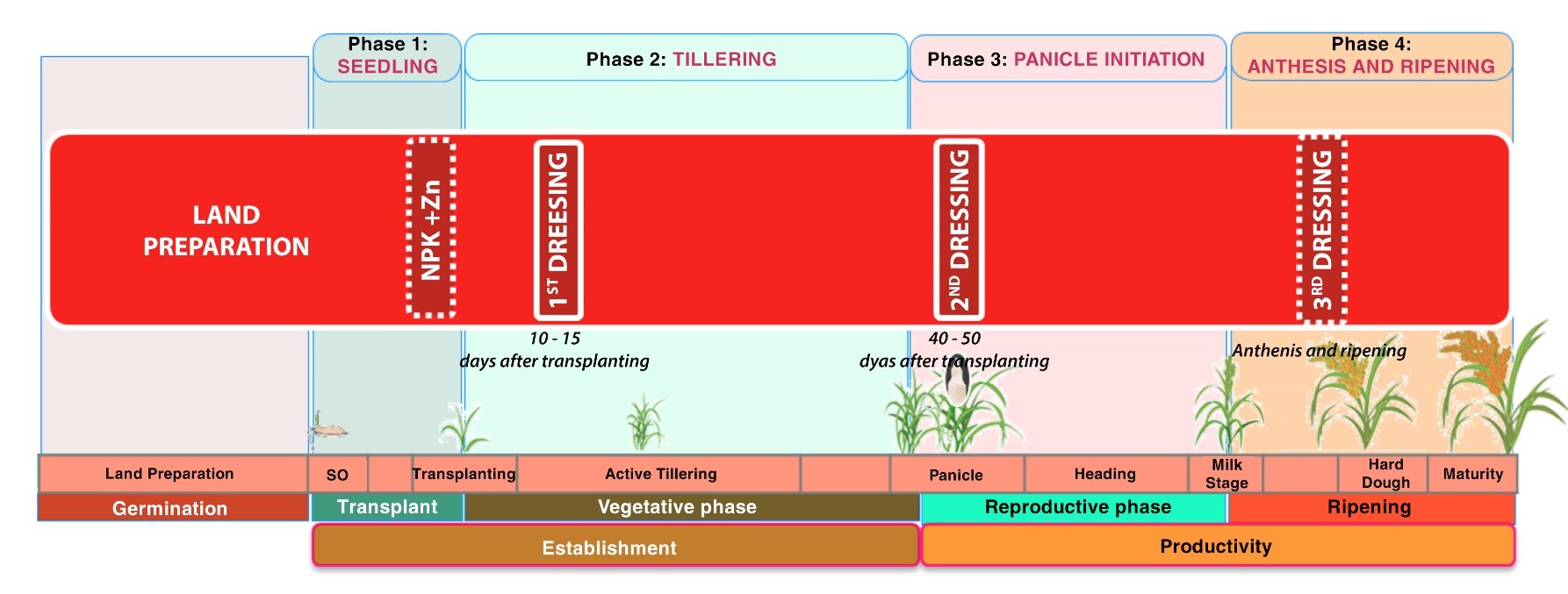
The first day of the transplanting(1st day)
At this time, the first application is very important.
| RECOMMENDED PRODUCTS | |
| Applying the nutrient-rich ingredients infuse with value-added biologicals performed to be effective for the prevention of the nematodes (especially a root-not disease) and fusarium at the roots. | |
| · MicrobeBio® Nature Vigor™ | Apply 1.9 kg (left – after using 100 g to treat the seeding) to treat a hectare. Note: Please carefully read the label instruction for the efficient yield. |
| Applying the product that contains the best source of mineral nutrients caters to the seedings to uptake the fast-released nutrients at the first stage of the seeding. | |
| · MicrobeBio® Hydro Activator™ | Apply 4 liters to treat a hectare. Note: Please carefully read the label instruction for the efficient yield. |
HOW IT WORKS
- The microbes adhere to the epidermis of the roots, forming a mutualistic relationship with the plant. The microbes feed off the secretes of the plant and distribute nitrogen daily throughout its growth cycle.
- The most effective action for this application is Trichoderma sp. during the rooting phase results in greater shoot lengths, as well as increased numbers of leaves, roots, stem diameters and promotes plant growth by both direct and indirect functions.
- Our other proprietary bacteria such as Bacillus sp., Azotobacter sp, Pseudomonas sp, and others start feeding off the exudates of plants and activating the great food sources from the soil.
- The product provides nutrient-rich ingredients infuse with value-added biologicals performed to be effective for the prevention of the fungi.
MICROBEBIO® NATURE VIGOR™
Introduction:
MicrobeBio® Nature Vigor™ consists of a synergistic consortium of naturally occurring soil microbes and organic matter designed to enhance virtually all crop types, soil conditions, and climates. It helps build and support the plant’s natural immune system to protect the plant from yield-robbing nematodes; thereby, promoting stronger, healthier roots and more robust yields.
MicrobeBio® Nature Vigor™ parasitizes all of the reproductive stages of plant pathogenic nematodes and fungi (fusarium), specifically focused on the eggs and females. The under acidic pH conditions produce a toxin that attacks the nervous system of the nematodes and causes deformations and destruction of the ovaries, which reduces egg fertility. This reduces the nematode population, which greatly protects the plant’s root system. By adding this layer of protection, the roots can develop and grow freely into a healthy root system. While MicrobeBio® Nature Vigor™ reduces the plant of pathogenic nematodes, it, in turn, promotes the reproduction and growth of beneficial nematodes, along with phosphorus and nitrogen-fixing microorganisms, allowing the plant to absorb more nutrients by the healthier grown root system.
MicrobeBio® Nature Vigor™ also allows the reproduction of beneficial nematodes and phosphorus and nitrogen-fixing microorganisms, thus allowing for the absorption of more nutrients by a healthy developed root system, stimulating significant plant growth. As a result, MicrobeBio® Nature Vigor™ improves drought tolerance, lowers irrigation requirement, increases seed and fruit production, stimulates larger blooms, enhances nutrient uptake, root development, and chlorophyll synthesis.
Notice: MicrobeBio® Nature Vigor™ is admixed with the special proprietary microorganisms to reduce the fungi and nematodes, so the product does not knockdown or control instant results as other chemical products in the market.
Benefits:
- Boost crop yields
- Reduce adverse environmental impacts
- Boost drought resistance
- Heal and protect soil
- Boost root vitality
- Boost seed germination
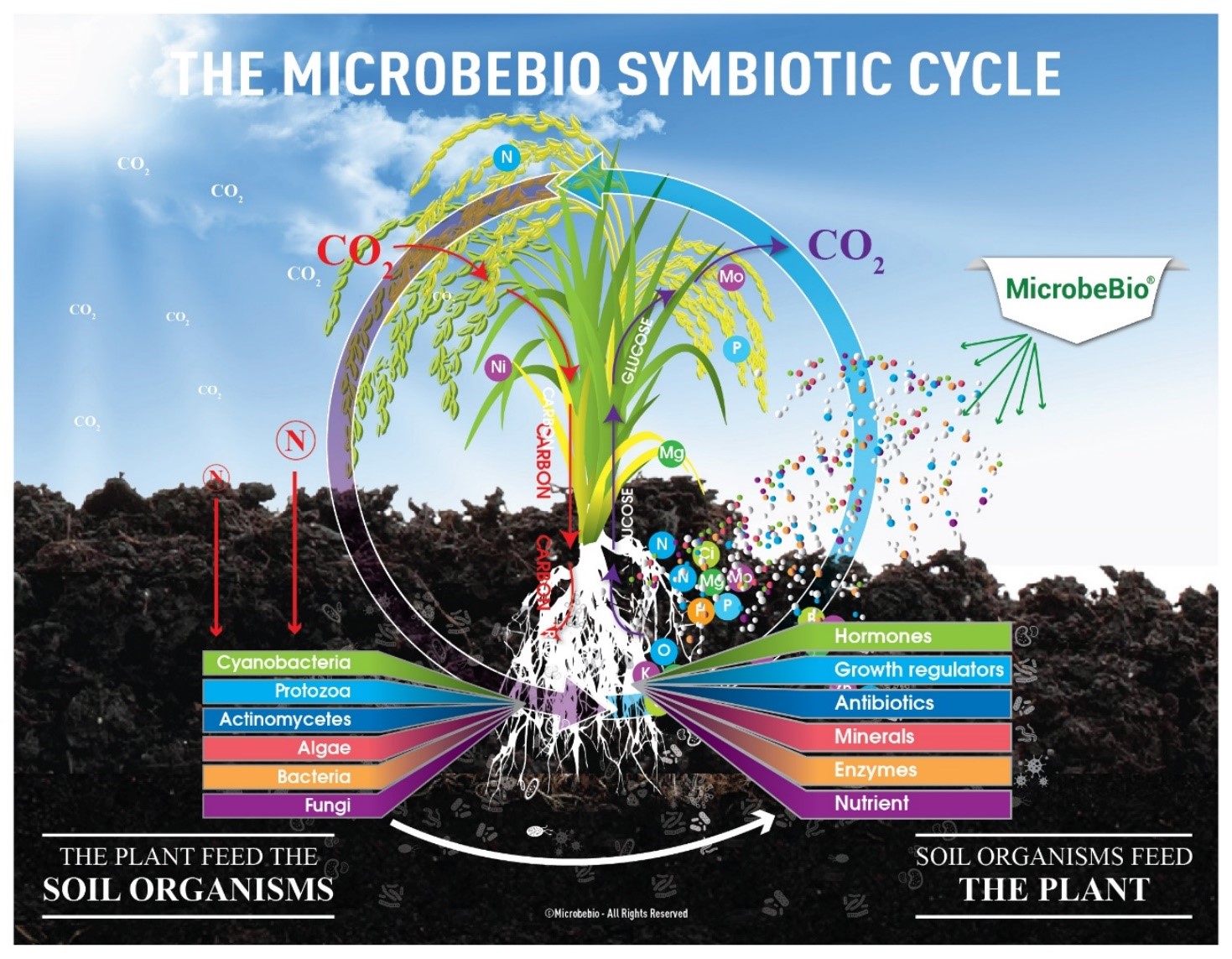
Nutrients from the product:
- Nitrogen is a component of many important organic compounds ranging from proteins to nucleic acids. The primary nutrient helps plant growing stronger and against plant pathogens.
- Phosphorus plays a central role in plants with energy transfer and protein metabolism against harmful fungi.
- Potassium helps in osmotic and ionic regulation. Potassium functions as a cofactor or activator for many enzymes of carbohydrate and protein metabolism that prevent parasitize all of the reproductive stages of plant pathogenic nematodes.
- Calcium is involved in cell division and plays a major role in the maintenance of membrane integrity. This is a vital element that helps plants grow and develop.
- Magnesium is known as a component of chlorophyll and a cofactor for many enzymatic reactions. The process will create the best protection on the leaf surface where the harmful pests or fungi hard to latch on.
- Sulfur is somewhat like phosphorus in that it is involved in plant cell energy that assists plants to reduce pathogenic nematodes and fungi.
- Iron is an essential component of many hemes and nonheme iron enzymes and carries, including the cytochromes (respiratory electron carriers) and the ferredoxins. The latter are involved in key metabolic functions such as Nitrogen fixation, photosynthesis, and electron transfer.
- Zinc is known as an essential component of several dehydrogenases, and peptidases, including carbonic anhydrase, alcohol dehydrogenase, glutamic dehydrogenase, and malic dehydrogenase, among others.
- Manganese is involved in the oxygen-evolving system of photosynthesis and is a component of the enzymes arginase and phosphorus transferases that is the best support for plants against pathogenic fungi and pests’ eggs.
- Copper is a constituent of several important enzymes, including cytochrome, oxidize ascorbic acid oxidase, and laccase.
- Boron involves in carbohydrate metabolism and synthesis of cell wall components that help plants against most the attack from plant pathogens.
- Molybdenum is required for the normal assimilation of nitrogen in plants. An essential component of nitrate reductase as well as nitrogenase (N2 fixation enzyme)
- Chlorine is essential for photosynthesis and is an activator of enzymes involved in splitting water. It also functions in the osmoregulation of plants growing on saline soils.
All proprietary beneficial microbes:
Our microbial products contain an unparalleled proprietary formula of 50+ strains of microorganisms. The most notable difference between our line of microbial products and that of other manufacturers is encompassed in the following three words: Bio-diversity, Endospores, and Equilibrium
- Bio-Diversity: This chain of 50+ strains of bio-diverse microorganisms are critical for promoting nutrient cycling in soil when applied to the root zone or as a foliar treatment. By contrast, mono-cultural strains (without diversity) are susceptible to environmental pathogens and more easily succumb to lysing, denaturation of their DNA, and death The bio-active potential of these microbial spores (vs. “live” microbes which live and die), ensure a longer duration of nutrient uptake by plants throughout all phases of the growth cycle
- Endospores: Our products contain viable bacteria, sporulated via fermentation. Rationale: Spores (vs. active cells) limit metabolism and catabolism, thereby increasing shelf life and minimizing excessive genetic mutation of bacterial cells, which can lead to mutant cells that do not perform the way they were intended. Converting our products into endospores ensures fidelity (long-term activity), significantly reduces genetic mutations, and stabilizes the quality of the product. By contrast, the quality of viable (“live”/active) cells in a container risks jug expansion or compression due to excess metabolism of CO2 production in the container. Endospores are the preferred form due to their preservation, fidelity, quality assurance of performance in the field, and high shelf life.
- Equilibrium: After many QA trials, we believe that heterogeneity of microbes promotes a prolonged duration of soil balance, resulting in season-long composting by the bacteria. Biodiversity and redundancy allows for accelerated organic mineralization in the soil nutrient release, perimeter protection against pathogens, improved soil tilth leading to better air and water channeling
All proprietary beneficial fungi to support root mass:
The product contains fungi supporting root extensions and yeast involving in secretory pathways of antibodies against diseases. Moreover, these fungi play a major role in the soil aggregation process and stimulate microbial activity that assists plant build and support the plant’s natural immune system to protect the plant from plant pathogens from fungi.
All proprietary beneficial vitamin sources:
The product contains the natural “bio-stimulant” for soil organisms and plants that support certain biological activators, to help plant against most plant pathogens from harmful nematodes, fungi, and pests.
All beneficial organic matter (more than 45% OM):
Presenting the best organic matter sources that belong to OMRI Standards.
Promote plant symbiotic cycle & photosynthesis by the proprietary plant probiotic formula:
- The product also contains a plant hormone component that helps:
- Promotes nutritional growth, increases chlorophyll content, and fiber weight in plants.
- Promotes development of leaf buds and flowers activates chlorophyll content and helps roots develop depth
- Highly efficient for propagation and micro-rooting
- Activate nitrogen absorption
- Complete the condensation of dry matter in the leaves where photosynthesis takes place
- Increased content of photosynthesis and assimilation of carbon dioxide.
- Increases seed donation and chlorophyll content of leaves.
Plant hormones work best when they are mixed with phytonutrients (highly difficult extraction technology) that act on a broad spectrum of plant cells to:
- Regulates absorption of ions into plant cells and reduces the heavy metal accumulation
- Improves the growth and perfection of photosynthesis through an antioxidant system when plants are exposed to cold climates
- Minimize cell damage caused by oxidation caused by high-temperature stress
- Helps to reduce water stress thanks to the oxidative system that reduces evapotranspiration, stomatal conductivity, and MDA content in seedlings.
- Reduces stress in the root zone by increasing the structure of the sugar-based carbon chain.
- Protects crops from herbicides, fungicides, and pesticides due to the increased ability of carbon dioxide to assimilate antioxidant enzymes.
MICROBEBIO® HYDRO ACTIVATOR™
Introduction:
MicrobeBio® Hydro Activator™ is an all-organic liquid fertilizer that was designed to promote the fruiting period and dramatically increase the Brix levels of productivity. MicrobeBio® Hydro Activator™ promotes earlier flowering and leads to larger blooms and fruit. Using MicrobeBio® Hydro Activator™ will greatly increase the quality of the product and slow the aging process. MicrobeBio® Hydro Activator™ is created with more than forty mineral elements, organic proteins, and essential amino acids that are made available for plants to uptake during the different stages of growth. It is packed full of the essential Macro and Micronutrients that are crucial for superior plant growth and development. You will see a major improvement in product quality when using MicrobeBio hydro activator – produce will look fresher, have healthier greener leaves, and will be significantly tastier, and have an increase in storage time.
Benefits:
- Immediately delivers primary nutrients (NPK) and renders them readily accessible for plant roots
- Furnishes a premium-selected sequential chain of sustainable, life-giving microbes for continuing soil and plant health
- Stimulates significant bio-mass (root) growth which is essential for plant health and growth
- Enhances plant BRIX levels (sugars) to enrich the bio-available food source for soil microbes
- Remediates salinity and heavy metal contamination in soils
- Improves water retention (by expanding the root system) and increases drought tolerance
- Balances pH in acid or alkaline conditions for optimal nutrient uptake
- Maintains a C:N Ratio (Carbon & Nitrogen) by activating microbes to release nutrients such as nitrogen, phosphorus, and zinc to crops
- Boosts chlorophyll content in leaves to invigorate the photosynthesis process
- Acts as a powerful prophylactic by preventing harmful Rhizoctonia and fusarium spores from germinating.
- Is comprised of 100% eco-friendly elements, which are non-toxic and are safe to use around children, adults, pets, and livestock.
1st Dressing Application (from day 10 to day 20 after the transplanting):
This is known as one of the critical rice plant growth stages. At this time, the seeding needs full nutrients for growing. From day 10 to day 20 after the transplanting, the baby rice plants are easily attacked by pests and fungi. Below is the list of common pests that are harmful to rice plants.
| Rice Stemborrer larva | African Rice Gal Midge larva | Termites larva | Rice Yellow Mottle Virus (early stage) |
Tips: Recommended to apply the MicrobeBio® products from the first start-up to the end of the season for the efficient yield.
| RECOMMENDED PRODUCTS | |
| At the vegetative phase, the soil needs to provide the nutrient-rich ingredients infuse with value-added biologicals performed for the growth stage. | |
| · MicrobeBio® Rhizo Activator™ | Apply 50 kg to treat a hectare (using the spreading method). |
| Providing the nutrient-rich ingredients infuse with value-added biologicals performed to be effective for the rice plants to prevent the pests at the early stage (larva). | |
| · MicrobeBio® Nature Vigor™ | Apply 2 kg to treat a hectare. Note: Please carefully read the label instruction for the efficient yield. |
| Applying the product that contains the best source of mineral nutrients caters to the seedlings to uptake the fast-released nutrients at the vegetative phase. | |
| · MicrobeBio® Hydro Activator | Apply 2 liters to treat a hectare. Note: Please carefully read the label instruction for the efficient yield. |
HOW IT WORKS
- The microbes adhere to the epidermis of the roots, forming a mutualistic relationship with the plant. The microbes feed off the secretes of the plant and distribute nitrogen daily throughout its growth cycle.
- The most effective action for this application is bio-control Bacillus spp. during the vegetative phase results in greater shoot lengths (preventing pathogenic fungi), as well as increased numbers of leaves, roots, stem diameters, and promotes plant growth by both direct and indirect functions.
- Our other proprietary bacteria such as Bacillus sp., Azotobacter sp, Pseudomonas sp, and others start feeding off the exudates of plants and activating the great food sources from the soil.
- The product provides nutrient-rich ingredients infuse with value-added biologicals performed to be effective for the reduction of fungi and pests at the early stage.
- The product’s spores, cysts & mycelia simply need to come in contact with a host. Once the host insect is infected, the microbes rapidly grow inside of the insect, feeding on the nutrients present in the host’s body and producing toxins in the process. When the host dies, the microbes cover the carcass in a layer of white mold that produces more infective spores.
- Entomopathogenic fungi – contact adherence of conidia to cuticle; spore germination; penetration inside host; vegetative growth in host’s hemolymph; production of new conidia upon the death of the host.
MICROBEBIO® NATURE VIGOR™
Introduction:
MicrobeBio® Nature Vigor™ comprises a synergistic consortium of naturally occurring probiotic soil microbes, macro/micronutrients, and organic matter designed to enhance virtually all crop types, soil conditions, and climates. It contains a natural rhizosphere bacterium that quickly populates the soil, forming protective colonies around delicate root hairs and on the leaf surface. Each gram-positive bacterium in this product, which survives in extreme environmental conditions including heat and drought, salinity, and extreme pH making it a durable, reliable, and effective reduction and suppression of soil-borne and foliar fungal and bacterial diseases, such as.
- Black Sigatoka (Mycosphaerella figiensis)
- Sheath blight of Rice (Rhizoctonia solani)
- Late Blight (Phytopthora infestans)
- Anthracnosis (Colletotrichum gloesporioides)
- Grey Mildew Disease (Ramularia areola)
- Powdery Mildew (Oidium spp.)
- Downy Mildew (Pernospora sparsa)
- Coffee Rust (Hemileia vastatrix)
- Ralstonia solanacearum that causes Bacterial Wilt
- Burkholderia glumae causing Panicle Blight of Rice
- Black Leg produced by Erwinia carotovora.
- Other common pathogenic plant fungi (Please contact the company for the further harmful fungi list appendix or the product SDS)
Furthermore, the product contains 100% organic nutrient-rich ingredients infused with value-added biologicals shown to be effective for the prevention and suppression outbreak of soft-bodied insects such as Alfalfa Weevil, Aphids, Apple Cleaving Moth, Fall Army Worms, Bark Beetles, Bean Leaf Beetle, Best Leafhopper, Beetles, Black Vine Weevil, Boll Weevil, Cabbage Looper, Cabbage Worm, Cane Borer, Caterpillars, Cereal Leaf Beetle, Chinch Bugs, Coffee Borer Beetle, Codling Moth, Colorado Potato Beetle, Corn Borer, Cucumber Beetle, Douglas Fir Tussock Moth, Emerald Ash Borer, Fire Ants Flies, Fungal Gnats, Grasshoppers, Greenhouse Whitefly, Invasive Silkworms, Japanese Beetle, Lygus Bugs, Mealybugs, Mexican Bean Beetle, Mites, Psyllids, Red Palm Weevil, Shore Flies, Stem Borers, Stink Bugs, Strawberry Root Weevil, Termites, Thrips, Whiteflies, White Grubs.
Notice: MicrobeBio® Nature Vigor™ is admixed with the special proprietary microorganisms to reduce the fungi and pests at the early stages, so the product does not knockdown or control instant results as other chemical products in the market.
Benefits:
- Boost crop yields
- Reduce adverse environmental impacts
- Boost drought resistance
- Heal and protect soil
- Boost root vitality
- Boost seed germination
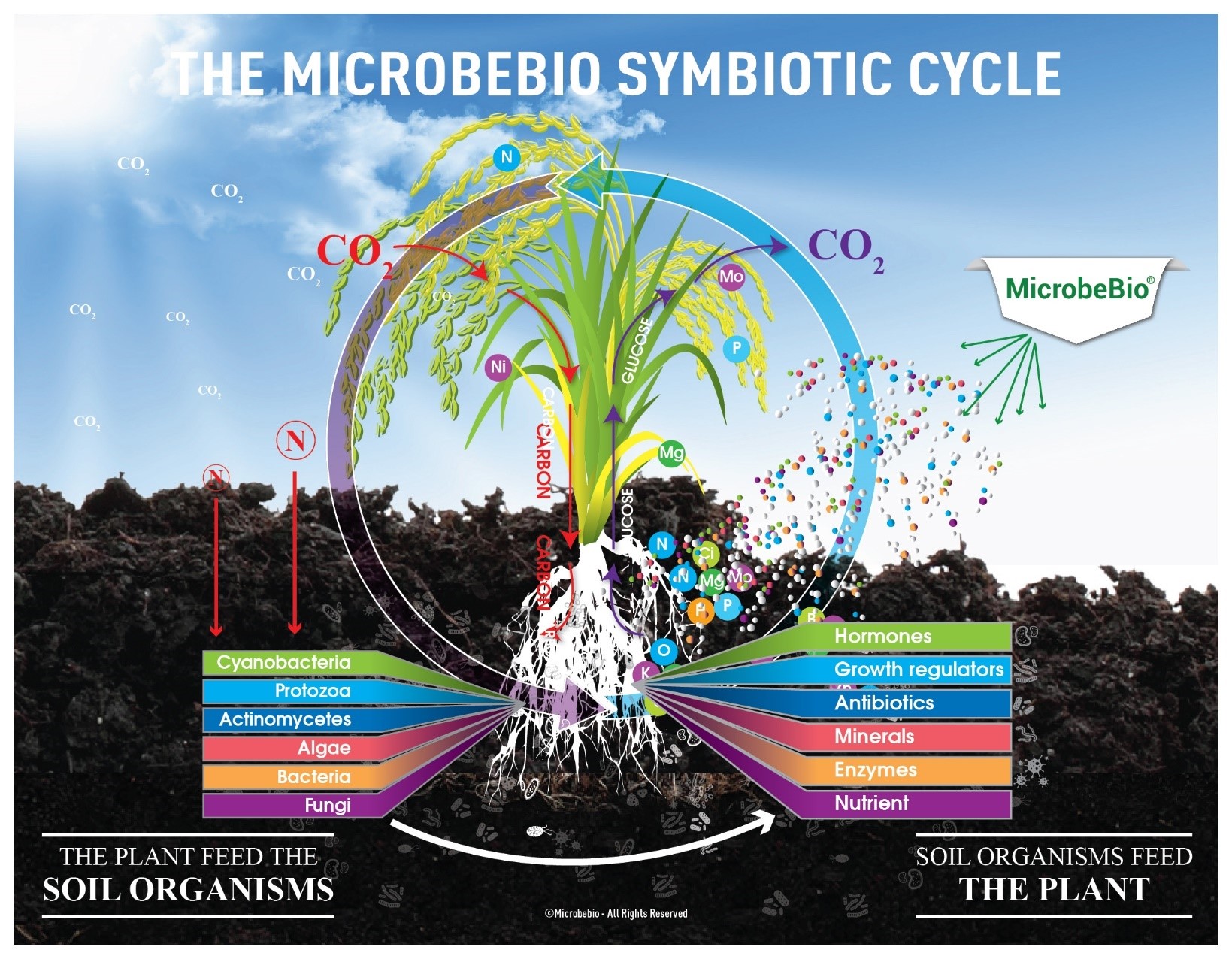
Nutrients from the product:
- Nitrogen is a component of many important organic compounds ranging from proteins to nucleic acids. The primary nutrient helps plant growing stronger and against plant pathogens.
- Phosphorus plays a central role in plants with energy transfer and protein metabolism against harmful fungi.
- Potassium helps in osmotic and ionic regulation. Potassium functions as a cofactor or activator for many enzymes of carbohydrate and protein metabolism that prevent parasitize all of the reproductive stages of plant pathogenic nematodes.
- Calcium is involved in cell division and plays a major role in the maintenance of membrane integrity. This is a vital element that helps plants grow and develop.
- Magnesium is known as a component of chlorophyll and a cofactor for many enzymatic reactions. The process will create the best protection on the leaf surface where the harmful pests or fungi hard to latch on.
- Sulfur is somewhat like phosphorus in that it is involved in plant cell energy that assists plants to reduce pathogenic nematodes and fungi.
- Iron is an essential component of many hemes and nonheme iron enzymes and carries, including the cytochromes (respiratory electron carriers) and the ferredoxins. The latter are involved in key metabolic functions such as Nitrogen fixation, photosynthesis, and electron transfer.
- Zinc is known as an essential component of several dehydrogenases, and peptidases, including carbonic anhydrase, alcohol dehydrogenase, glutamic dehydrogenase, and malic dehydrogenase, among others.
- Manganese is involved in the oxygen-evolving system of photosynthesis and is a component of the enzymes arginase and phosphorus transferases that is the best support for plants against pathogenic fungi and pests’ eggs.
- Copper is a constituent of several important enzymes, including cytochrome, oxidize ascorbic acid oxidase, and laccase.
- Boron involves in carbohydrate metabolism and synthesis of cell wall components that help plants against most the attack from plant pathogens.
- Molybdenum is required for the normal assimilation of nitrogen in plants. An essential component of nitrate reductase as well as nitrogenase (N2 fixation enzyme)
- Chlorine is essential for photosynthesis and is an activator of enzymes involved in splitting water. It also functions in the osmoregulation of plants growing on saline soils.
All proprietary beneficial microbes:
Our microbial products contain an unparalleled proprietary formula of 50+ strains of microorganisms. The most notable difference between our line of microbial products and that of other manufacturers is encompassed in the following three words: Bio-diversity, Endospores, and Equilibrium
- Bio-Diversity: This chain of 50+ strains of bio-diverse microorganisms are critical for promoting nutrient cycling in soil when applied to the root zone or as a foliar treatment. By contrast, mono-cultural strains (without diversity) are susceptible to environmental pathogens and more easily succumb to lysing, denaturation of their DNA, and death The bio-active potential of these microbial spores (vs. “live” microbes which live and die), ensure a longer duration of nutrient uptake by plants throughout all phases of the growth cycle
- Endospores: Our products contain viable bacteria, sporulated via fermentation. Rationale: Spores (vs. active cells) limit metabolism and catabolism, thereby increasing shelf life and minimizing excessive genetic mutation of bacterial cells, which can lead to mutant cells that do not perform the way they were intended. Converting our products into endospores ensures fidelity (long-term activity), significantly reduces genetic mutations, and stabilizes the quality of the product. By contrast, the quality of viable (“live”/active) cells in a container risks jug expansion or compression due to excess metabolism of CO2 production in the container. Endospores are the preferred form due to their preservation, fidelity, quality assurance of performance in the field, and high shelf life.
- Equilibrium: After many QA trials, we believe that heterogeneity of microbes promotes a prolonged duration of soil balance, resulting in season-long composting by the bacteria. Biodiversity and redundancy allows for accelerated organic mineralization in the soil nutrient release, perimeter protection against pathogens, improved soil tilth leading to better air and water channeling
All proprietary beneficial fungi to support root mass:
The product contains fungi supporting root extensions and yeast involving in secretory pathways of antibodies against diseases. Moreover, these fungi play a major role in the soil aggregation process and stimulate microbial activity that assists plant build and support the plant’s natural immune system to protect the plant from plant pathogens from fungi.
All proprietary beneficial vitamin sources:
The product contains the natural “bio-stimulant” for soil organisms and plants that support certain biological activators, to help plant against most plant pathogens from harmful nematodes, fungi, and pests.
All beneficial organic matter (more than 45% OM):
Presenting the best organic matter sources that belong to OMRI Standards.
Promote plant symbiotic cycle & photosynthesis by the proprietary plant probiotic formula:
- The product also contains a plant hormone component that helps:
- Promotes nutritional growth, increases chlorophyll content, and fiber weight in plants.
- Promotes development of leaf buds and flowers activates chlorophyll content and helps roots develop depth
- Highly efficient for propagation and micro-rooting
- Activate nitrogen absorption
- Complete the condensation of dry matter in the leaves where photosynthesis takes place
- Increased content of photosynthesis and assimilation of carbon dioxide.
- Increases seed donation and chlorophyll content of leaves.
Plant hormones work best when they are mixed with phytonutrients (highly difficult extraction technology) that act on a broad spectrum of plant cells to:
- Regulates absorption of ions into plant cells and reduces the heavy metal accumulation
- Improves the growth and perfection of photosynthesis through an antioxidant system when plants are exposed to cold climates
- Minimize cell damage caused by oxidation caused by high-temperature stress
- Helps to reduce water stress thanks to the oxidative system that reduces evapotranspiration, stomatal conductivity, and MDA content in seedlings.
- Reduces stress in the root zone by increasing the structure of the sugar-based carbon chain.
- Protects crops from herbicides, fungicides, and pesticides due to the increased ability of carbon dioxide to assimilate antioxidant enzyme
HOW MICROBEBIO® NATURE VIGOR WORKS:
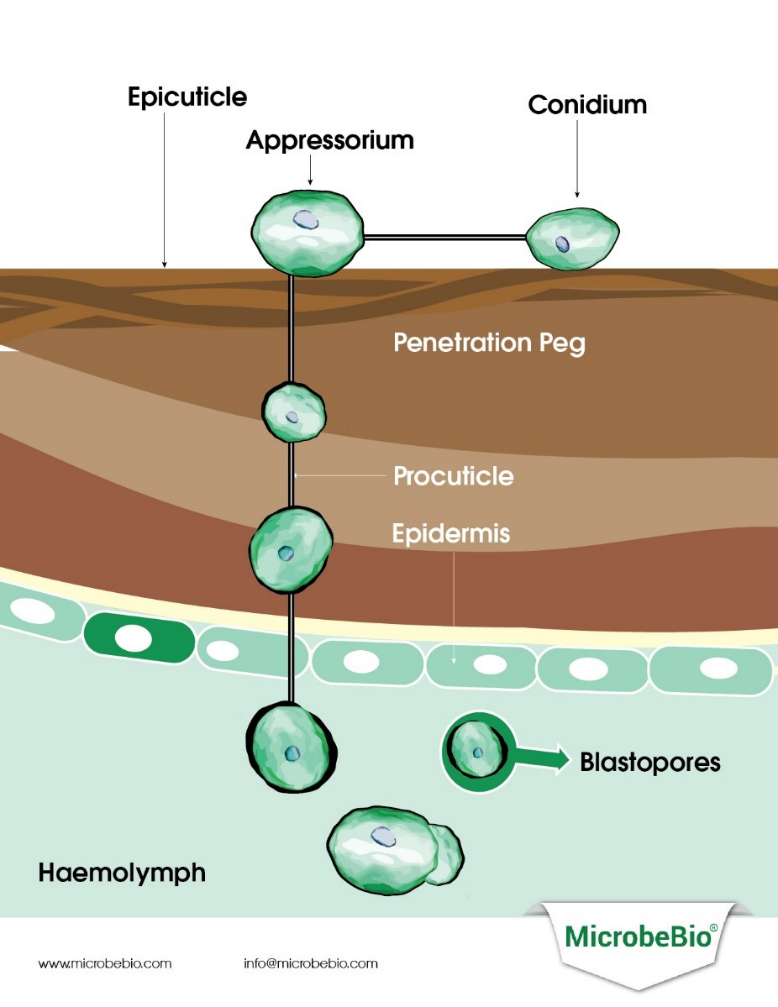
MicrobeBio® Nature Vigor ™ makes a protein precious crystal inside the spore that is harmful when devoured by specific bugs. This one-of-a-kind bacterium hinders the arrangement of the bug’s stomach that shields it from its stomach-related juices. It infiltrates the bug stomach, which at that point slaughters it through harming of the stomach substance and the spores themselves. MicrobeBio® Nature Vigor™ is harmless to birds, fish, and warm-blooded creatures because of their acidic gut conditions which could nullify the microbes’ impact. Water-use proficiency is improved because of expanded natural matter. There is no requirement for exceptional dealing with, this is a profoundly successful, prudent green option in contrast to caustic/harmful mixes. MicrobeBio® Nature Vigor™ is recommended to be applied directly to the infected areas to prevent population flare-ups.
These eco-safe microbial groups have good colonization abilities and production of endospores. The mutual interaction to plant to make bio-film to protect plant directly or indirectly to improving induce plant immunity against physical and biological environmental stresses and also stimulate to physiological and produce phytohormones. Biological control over plant areal fungal phytopathogen via colonization and defensive retention of phyllospheric niches are enabled by the production of bacterial allelochemicals, including iron-chelating siderophores, antibiotics, biocidal volatiles, lytic enzymes, and detoxification enzymes.
MicrobeBio® Nature Vigor™ spores, cysts & mycelia simply need to come in contact with a host. Once the host insect is infected, the microbes rapidly grow inside of the insect, feeding on the nutrients present in the host’s body and producing toxins in the process. When the host dies, the microbes cover the carcass in a layer of white mold that produces more infective spores.
Entomopathogenic fungi – contact adherence of conidia to cuticle; spore germination; penetration inside host; vegetative growth in host’s hemolymph; production of new conidia upon the death of the host.
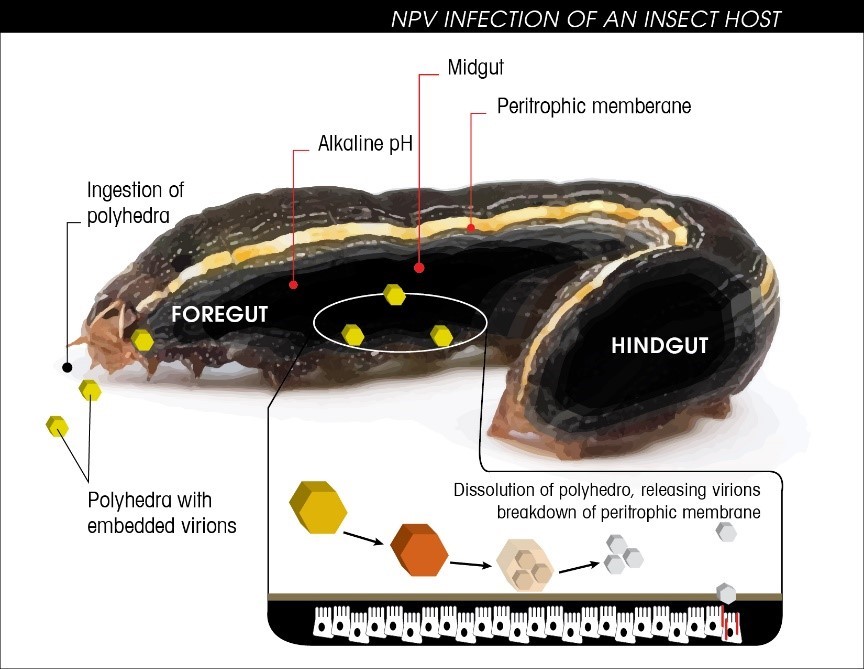
HOW MICROBEBIO® NATURE VIGOR WORKS ON JAPANESE BEETLES:
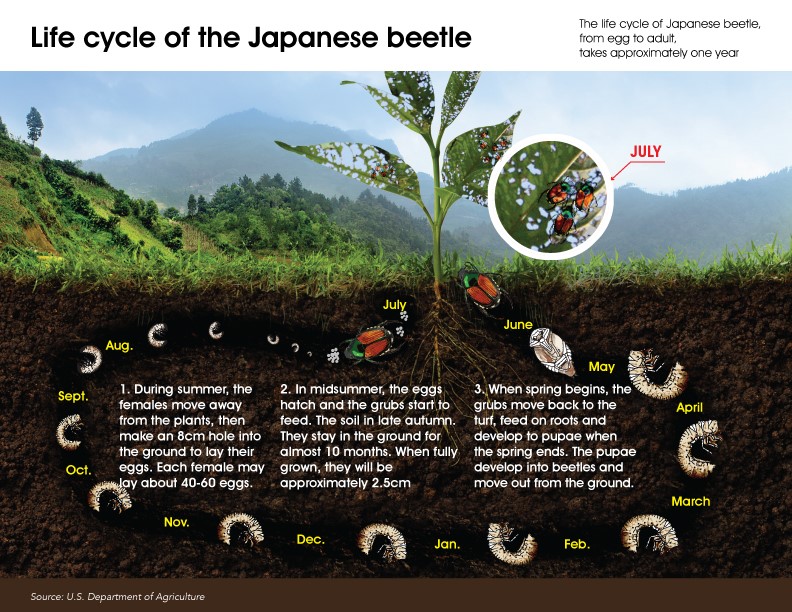
MicrobeBio® Nature Vigor contains immediately impacts the exoskeleton structure of the Japanese Beetle from the grub to adult stages. The product contains vital micro-organisms providing reasonable levels of reduction in generally safer than chemical insecticides and pesticides in the markets.
Special micro-organisms can break down lepidopterans or coleopterans of the insects or pests.
Special fungi grow naturally throughout the world and act as a parasite on various arthropod species. It is being used as biological insecticides or pesticides to control the number of tough pests such as termites, thrips, whiteflies, aphids, fall armyworms, Japanese beetles, and other different beetles.
HOW MICROBEBIO® NATURE VIGOR WORKS ON ARMYWORMS:
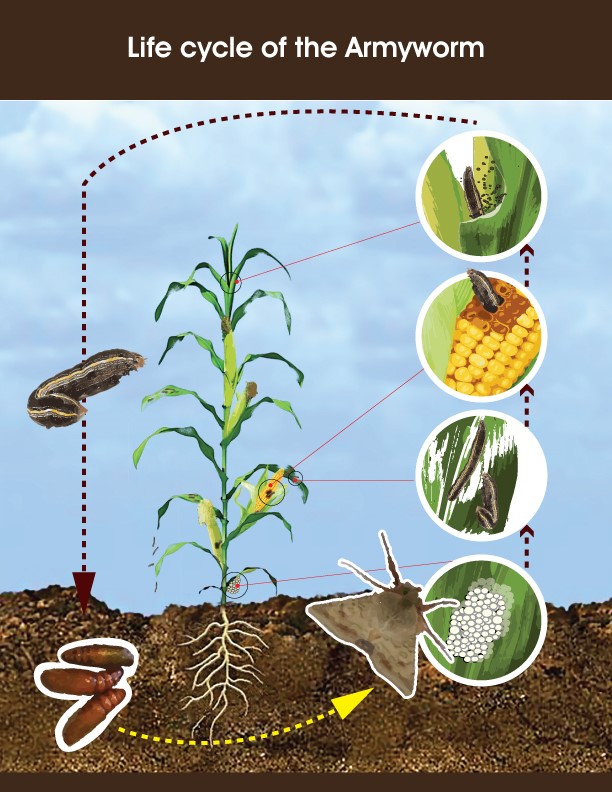
MicrobeBio® Nature Vigor™ presents the eco-safe microbial group that has good colonization abilities and production of endospores. The mutual interaction to plant to make bio-film to protect plant directly or indirectly to improving induce plant immunity against physical and biological environmental stresses and also stimulate to physiological and produce phytohormones. Biological control over plant areal fungal phytopathogen via colonization and defensive retention of phyllosphere niches are enabled by the production of bacterial allelochemicals, including iron-chelating siderophores, antibiotics, biocidal volatiles, lytic enzymes, and detoxification enzymes.
MicrobeBio® Nature Vigor™ spores, cysts & mycelia simply need to come in contact with a host. Once the host insect is infected, the microbes rapidly grow inside of the insect, feeding on the nutrients present in the host’s body and producing toxins in the process. When the host dies, the microbes cover the carcass in a layer of white mold that produces more infective spores. Entomopathogenic fungi – contact adherence of conidia to cuticle; spore germination; penetration inside host; vegetative growth in host’s hemolymph; production of new conidia upon the death of the host.
MICROBEBIO® HYDRO ACTIVATOR™
Introduction:
MicrobeBio® Hydro Activator™ is an all-organic liquid fertilizer that was designed to promote the fruiting period and dramatically increase the Brix levels of productivity. MicrobeBio® Hydro Activator™ promotes earlier flowering and leads to larger blooms and fruit. Using MicrobeBio® Hydro Activator™ will greatly increase the quality of the product and slow the aging process. MicrobeBio® Hydro Activator™ is created with more than forty mineral elements, organic proteins, and essential amino acids that are made available for plants to uptake during the different stages of growth. It is packed full of the essential Macro and Micronutrients that are crucial for superior plant growth and development. You will see a major improvement in product quality when using MicrobeBio hydro activator – produce will look fresher, have healthier greener leaves, and will be significantly tastier, and have an increase in storage time.
Benefits:
- Immediately delivers primary nutrients (NPK) and renders them readily accessible for plant roots
- Furnishes a premium-selected sequential chain of sustainable, life-giving microbes for continuing soil and plant health
- Stimulates significant bio-mass (root) growth which is essential for plant health and growth
- Enhances plant BRIX levels (sugars) to enrich the bio-available food source for soil microbes
- Remediates salinity and heavy metal contamination in soils
- Improves water retention (by expanding the root system) and increases drought tolerance
- Balances pH in acid or alkaline conditions for optimal nutrient uptake
- Maintains a C:N Ratio (Carbon & Nitrogen) by activating microbes to release nutrients such as nitrogen, phosphorus, and zinc to crops
- Boosts chlorophyll content in leaves to invigorate the photosynthesis process
- Acts as a powerful prophylactic by preventing harmful Rhizoctonia and fusarium spores from germinating.
- Is comprised of 100% eco-friendly elements, which are non-toxic and are safe to use around children, adults, pets, and livestock.
MICROBEBIO® RHIZO ACTIVATOR™
Introduction:
MicrobeBio® Rhizo Activator™ is an all-natural and organic granular slow-release fertilizer enhanced with mycorrhizae and beneficial microbes that were designed to primarily stimulate plant root growth. Rhizo Activator is packed full of essential beneficial microbes, Macro, and Micronutrients that are crucial to superior plant growth, and delivers these nutrients in a form that is consistently available for the plant’s immediate use. Rhizo Activator contains primary and secondary nutrients, along with organic matter with available nitrogen sources, as well as bio-stimulants and advanced biological humic and fulvic acids. This combination of organic and mineral elements establishes the fundamental food sources needed in order to stimulate the colonization of beneficial soil microbes, regardless of the crop or condition of the soil. Once MicrobeBio Rhizo Activator is applied to the soil, millions upon millions of these beneficial bacteria and microbes begin to make their way to the plant root zone to develop and form a fully functional extended network of fine filaments that covers over seven hundred times more soil area. This establishes and forms a symbiotic relationship, colonizing the plant’s root zone and providing it with a greater increase in water and nutrient absorption efficiency. The increase in the plant’s root mass allows for the plant to reach more of the beneficial nutrients and water that would have otherwise been unavailable for use without having used Rhizo Activator. The plant will also show improved drought tolerance and have much lower irrigation requirements. Rhizo Activator will strengthen the entire plant’s root system, allowing the plant to grow stronger, bigger, and more vigorous. This leads to generating a higher yield and better protection against pests, disease, and unfavorable environmental conditions. Rhizo Activator greatly enhances bio-geochemical processes such as the Carbon Cycle, Nitrogen Cycle, Mineralization, as well as Decomposition. It gives the soil the ability to better hold, convert, stabilize and increase the nitrogen. Rhizo Activator ensures the absorption of the available bio-stimulants and helps to fight the nutrient deterioration in nearby sources of water. This is because our product was designed to break down slowly in conjunction with the response produced by the plant, rather than merely dissolving in water. This results in a major reduction of groundwater leeching and excess runoff of nutrients. MicrobeBio Rhizo Activator is an all-around environmentally friendly agricultural product that majorly minimizes nutrient pollution.
Benefits:
- Improved root depth and density.
- Stimulate biological activity by increasing microbial colony.
- Stimulate plant growth and increased yield
- Deliver primary nutrient source of food for plants
- Remediate salinity and heavy metal contamination in soils
- Regulate pH in acid or alkaline conditions
- Increases BRIX levels
- Increase organic matter and Carbon source
- Increase Chlorophyll Content
- Enhance natural defenses
- Improve water retention
- Improve soil structure
2nd Dressing Application (from day 40 to day 50 after the transplanting)
The panicle initiation of the vegetative phase is the second critical stage of the rice plant growth. The farmers should observe the rice field so that they can plan to prevent the pathogenic pests and insects at the larva stage. Furthermore, the farmers should apply nutrients to help the rice plant grow. Below is the list of common pests that are harmful to rice plants:
| Rice Stemborrer | African Rice Gal Midge | Termites | Rice Yellow Mottle Virus |
Tips: Recommended to apply the MicrobeBio® products from the first start-up to the end of the season for the efficient yield.
| RECOMMENDED PRODUCTS | |
| At the vegetative phase, the soil needs to provide the nutrient-rich ingredients infuse with value-added biologicals performed for the price plants against the pathogenic fungi from the environment; the pests and insects from the environment. | |
| · MicrobeBio® Nature Vigor ™ | Apply 2 kg to treat a hectare. Note: Please carefully read the label instruction for the efficient yield. |
| At the vegetative phase, the soil needs to provide the nutrient-rich ingredients infuse with value-added biologicals performed for the price plants against the pathogenic fungi from the environment. | |
| · MicrobeBio® Hydro Activator | Apply 4 liters to treat a hectare. Note: Please carefully read the label instruction for the efficient yield. |
HOW IT WORKS
- The microbes adhere to the epidermis of the roots, forming a mutualistic relationship with the plant. The microbes feed off the secretes of the plant and distribute nitrogen daily throughout its growth cycle.
- Our other proprietary bacteria such as Bacillus sp., Azotobacter sp, Pseudomonas sp, and others start feeding off the exudates of plants and activating the great food sources from the soil.
- The product provides nutrient-rich ingredients infuse with value-added biologicals performed to be effective for the prevention of fungi and pests at the early stage.
MICROBEBIO® NATURE VIGOR™
Introduction:
MicrobeBio® Nature Vigor™ comprises a synergistic consortium of naturally occurring probiotic soil microbes, macro/micronutrients, and organic matter designed to enhance virtually all crop types, soil conditions, and climates. It contains a natural rhizosphere bacterium that quickly populates the soil, forming protective colonies around delicate root hairs and on the leaf surface. Each gram-positive bacterium in this product, which survives in extreme environmental conditions including heat and drought, salinity, and extreme pH making it a durable, reliable, and effective reduction and slight prevention of the outbreak of soft-bodied insects and pests such as Alfalfa Weevil, Aphids, Apple Cleaving Moth, Fall Army Worms, Bark Beetles, Bean Leaf Beetle, Best Leafhopper, Beetles, Black Vine Weevil, Boll Weevil, Cabbage Looper, Cabbage Worm, Cane Borer, Caterpillars, Cereal Leaf Beetle, Chinch Bugs, Coffee Borer Beetle, Codling Moth, Colorado Potato Beetle, Corn Borer, Cucumber Beetle, Douglas Fir Tussock Moth, Emerald Ash Borer, Fire Ants Flies, Fungal Gnats, Grasshoppers, Greenhouse Whitefly, Invasive Silkworms, Japanese Beetle, Lygus Bugs, Mealybugs, Mexican Bean Beetle, Mites, Psyllids, Red Palm Weevil, Shore Flies, Stem Borers, Stink Bugs, Strawberry Root Weevil, Termites, Thrips, Whiteflies, White Grubs.
Notice: MicrobeBio® Nature Vigor™ is admixed with the special proprietary microorganisms to reduce insects and pests, so the product does not knockdown or control instant results as other chemical products in the market
Benefits:
- Boost crop yields
- Reduce adverse environmental impacts
- Boost drought resistance
- Heal and protect soil
- Boost root vitality
- Boost seed germination
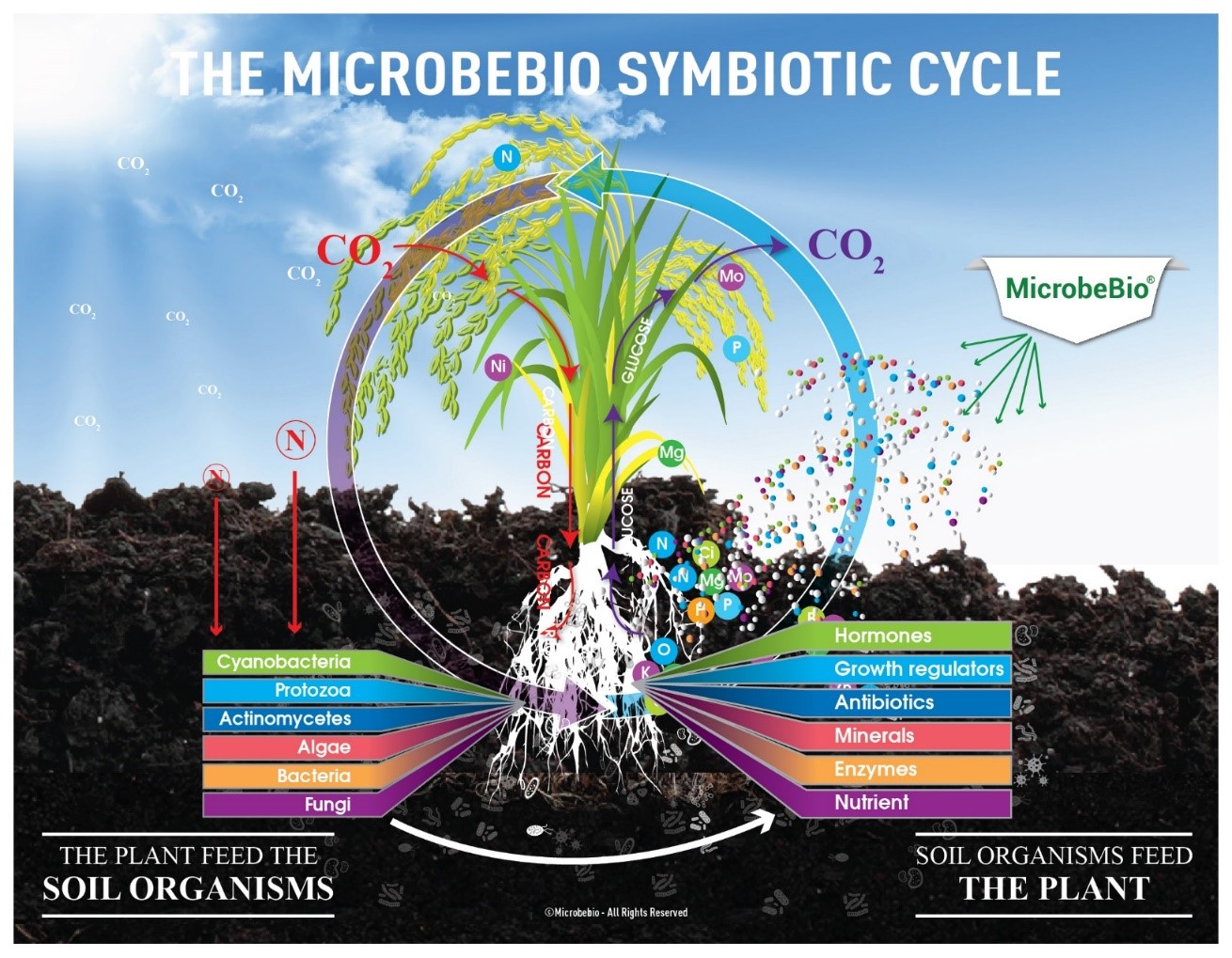
Nutrients from the product:
- Nitrogen is a component of many important organic compounds ranging from proteins to nucleic acids. The primary nutrient helps plant growing stronger and against plant pathogens.
- Phosphorus plays a central role in plants with energy transfer and protein metabolism against harmful fungi.
- Potassium helps in osmotic and ionic regulation. Potassium functions as a cofactor or activator for many enzymes of carbohydrate and protein metabolism that prevent parasitize all of the reproductive stages of plant pathogenic nematodes.
- Calcium is involved in cell division and plays a major role in the maintenance of membrane integrity. This is a vital element that helps plants grow and develop.
- Magnesium is known as a component of chlorophyll and a cofactor for many enzymatic reactions. The process will create the best protection on the leaf surface where the harmful pests or fungi hard to latch on.
- Sulfur is somewhat like phosphorus in that it is involved in plant cell energy that assists plants to reduce pathogenic nematodes and fungi.
- Iron is an essential component of many hemes and nonheme iron enzymes and carries, including the cytochromes (respiratory electron carriers) and the ferredoxins. The latter are involved in key metabolic functions such as Nitrogen fixation, photosynthesis, and electron transfer.
- Zinc is known as an essential component of several dehydrogenases, and peptidases, including carbonic anhydrase, alcohol dehydrogenase, glutamic dehydrogenase, and malic dehydrogenase, among others.
- Manganese is involved in the oxygen-evolving system of photosynthesis and is a component of the enzymes arginase and phosphorus transferases that is the best support for plants against pathogenic fungi and pests’ eggs.
- Copper is a constituent of several important enzymes, including cytochrome, oxidize ascorbic acid oxidase, and laccase.
- Boron involves in carbohydrate metabolism and synthesis of cell wall components that help plants against most the attack from plant pathogens.
- Molybdenum is required for the normal assimilation of nitrogen in plants. An essential component of nitrate reductase as well as nitrogenase (N2 fixation enzyme)
- Chlorine is essential for photosynthesis and is an activator of enzymes involved in splitting water. It also functions in the osmoregulation of plants growing on saline soils.
All proprietary beneficial microbes:
Our microbial products contain an unparalleled proprietary formula of 50+ strains of microorganisms. The most notable difference between our line of microbial products and that of other manufacturers is encompassed in the following three words: Bio-diversity, Endospores, and Equilibrium
- Bio-Diversity: This chain of 50+ strains of bio-diverse microorganisms are critical for promoting nutrient cycling in soil when applied to the root zone or as a foliar treatment. By contrast, mono-cultural strains (without diversity) are susceptible to environmental pathogens and more easily succumb to lysing, denaturation of their DNA, and death The bio-active potential of these microbial spores (vs. “live” microbes which live and die), ensure a longer duration of nutrient uptake by plants throughout all phases of the growth cycle
Endospores: Our products contain viable bacteria, sporulated via fermentation. Rationale: Spores (vs. active cells) limit metabolism and catabolism, thereby increasing shelf life and minimizing excessive genetic mutation of bacterial cells, which can lead to mutant cells that do not perform the way they were intended. Converting our products into endospores ensures fidelity (long-term activity), significantly reduces genetic mutations, and stabilizes the quality of the product. By contrast, the quality of viable (“live”/active) cells in a container risks jug expansion or compression due to excess metabolism of CO2 production in the container.
- Endospores are the preferred form due to their preservation, fidelity, quality assurance of performance in the field, and high shelf life.
- Equilibrium: After many QA trials, we believe that heterogeneity of microbes promotes a prolonged duration of soil balance, resulting in season-long composting by the bacteria. Biodiversity and redundancy allows for accelerated organic mineralization in the soil nutrient release, perimeter protection against pathogens, improved soil tilth leading to better air and water channeling
All proprietary beneficial fungi to support root mass:
The product contains fungi supporting root extensions and yeast involving in secretory pathways of antibodies against diseases. Moreover, these fungi play a major role in the soil aggregation process and stimulate microbial activity that assists plant build and support the plant’s natural immune system to protect the plant from plant pathogens from fungi.
All proprietary beneficial vitamin sources:
The product contains the natural “bio-stimulant” for soil organisms and plants that support certain biological activators, to help plant against most plant pathogens from harmful nematodes, fungi, and pests.
All beneficial organic matter (more than 45% OM):
Presenting the best organic matter sources that belong to OMRI Standards.
Promote plant symbiotic cycle & photosynthesis by the proprietary plant probiotic formula:
- The product also contains a plant hormone component that helps:
- Promotes nutritional growth, increases chlorophyll content, and fiber weight in plants.
- Promotes development of leaf buds and flowers activates chlorophyll content and helps roots develop depth
- Highly efficient for propagation and micro-rooting
- Activate nitrogen absorption
- Complete the condensation of dry matter in the leaves where photosynthesis takes place
- Increased content of photosynthesis and assimilation of carbon dioxide.
- Increases seed donation and chlorophyll content of leaves.
Plant hormones work best when they are mixed with phytonutrients (highly difficult extraction technology) that act on a broad spectrum of plant cells to:
- Regulates absorption of ions into plant cells and reduces the heavy metal accumulation
- Improves the growth and perfection of photosynthesis through an antioxidant system when plants are exposed to cold climates
- Minimize cell damage caused by oxidation caused by high-temperature stress
- Helps to reduce water stress thanks to the oxidative system that reduces evapotranspiration, stomatal conductivity, and MDA content in seedlings.
- Reduces stress in the root zone by increasing the structure of the sugar-based carbon chain.
- Protects crops from herbicides, fungicides, and pesticides due to the increased ability of carbon dioxide to assimilate antioxidant enzyme.
HOW MICROBEBIO® NATURE VIGOR WORKS:
MicrobeBio® Nature Vigor ™ makes a protein precious crystal inside the spore that is harmful when devoured by specific bugs. This one-of-a-kind bacterium hinders the arrangement of the bug’s stomach that shields it from its stomach-related juices. It infiltrates the bug stomach, which at that point slaughters it through harming of the stomach substance and the spores themselves. MicrobeBio® Nature Vigor™ is harmless to birds, fish, and warm-blooded creatures because of their acidic gut conditions which could nullify the microbes’ impact. Water-use proficiency is improved because of expanded natural matter. There is no requirement for exceptional dealing with, this is a profoundly successful, prudent green option in contrast to caustic/harmful mixes. MicrobeBio® Nature Vigor™ is recommended to be applied directly to the infected areas to prevent population flare-ups.
These eco-safe microbial groups have good colonization abilities and production of endospores. The mutual interaction to plant to make bio-film to protect plant directly or indirectly to improving induce plant immunity against physical and biological environmental stresses and also stimulate to physiological and produce phytohormones. Biological control over plant areal fungal phytopathogen via colonization and defensive retention of phyllospheric niches are enabled by the production of bacterial allelochemicals, including iron-chelating siderophores, antibiotics, biocidal volatiles, lytic enzymes, and detoxification enzymes.
MicrobeBio® Nature Vigor™ spores, cyst & mycelia simply need to come in contact with a host. Once the host insect is infected, the microbes rapidly grow inside of the insect, feeding on the nutrients present in the host’s body and producing toxins in the process. When the host dies, the microbes cover the carcass in a layer of white mold that produces more infective spores.
Entomopathogenic fungi – contact adherence of conidia to cuticle; spore germination; penetration inside host; vegetative growth in host’s hemolymph; production of new conidia upon the death of the host.
HOW MICROBEBIO® NATURE VIGOR WORKS ON JAPANESE BEETLES:
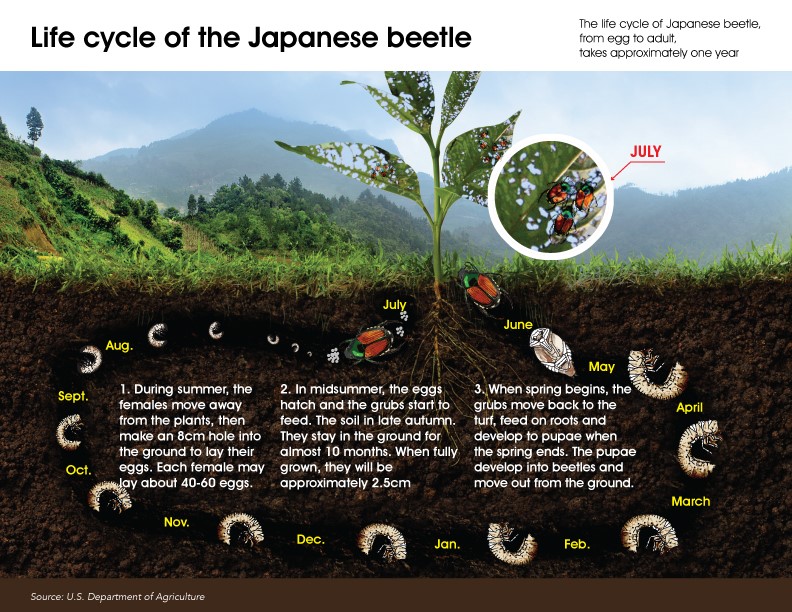
MicrobeBio® Nature Vigor contains immediately impacts the exoskeleton structure of the Japanese Beetle from the grub to adult stages. The product contains vital micro-organisms providing reasonable levels of prevention in generally safer than chemical insecticides and pesticides in the markets.
Special micro-organisms can break down lepidopterans or coleopterans of the insects or pests.
Special fungi grow naturally throughout the world and act as a parasite on various arthropod species. It is being used as biological insecticides or pesticides to control the number of tough pests such as termites, thrips, whiteflies, aphids, fall armyworms, Japanese beetles, and other different beetles.
HOW MICROBEBIO® NATURE VIGOR WORKS ON ARMYWORMS:
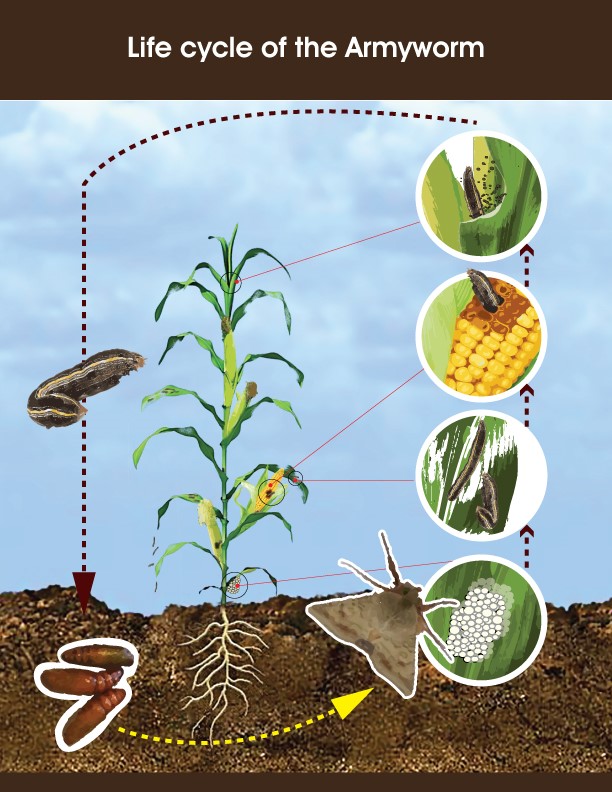
MicrobeBio® Nature Vigor™presents the eco-safe microbial group that has good colonization abilities and production of endospores. The mutual interaction to plant to make bio-film to protect plant directly or indirectly to improving induce plant immunity against physical and biological environmental stresses and also stimulate to physiological and produce phytohormones. Biological control over plant areal fungal phytopathogen via colonization and defensive retention of phyllosphere niches are enabled by the production of bacterial allelochemicals, including iron-chelating siderophores, antibiotics, biocidal volatiles, lytic enzymes, and detoxification enzymes.
MicrobeBio® Nature Vigor™ spores, cysts & mycelia simply need to come in contact with a host. Once the host insect is infected, the microbes rapidly grow inside of the insect, feeding on the nutrients present in the host’s body and producing toxins in the process. When the host dies, the microbes cover the carcass in a layer of white mold that produces more infective spores. Entomopathogenic fungi – contact adherence of conidia to cuticle; spore germination; penetration inside host; vegetative growth in host’s hemolymph; production of new conidia upon the death of the host.
MICROBEBIO® HYDRO ACTIVATOR™
Introduction:
MicrobeBio® Hydro Activator™ is an all-organic liquid fertilizer that was designed to promote the fruiting period and dramatically increase the Brix levels of productivity. MicrobeBio® Hydro Activator™ promotes earlier flowering and leads to larger blooms and fruit. Using MicrobeBio® Hydro Activator™ will greatly increase the quality of the product and slow the aging process. MicrobeBio® Hydro Activator™ is created with more than forty mineral elements, organic proteins, and essential amino acids that are made available for plants to uptake during the different stages of growth. It is packed full of the essential Macro and Micronutrients that are crucial for superior plant growth and development. You will see a major improvement in product quality when using MicrobeBio hydro activator – produce will look fresher, have healthier greener leaves, and will be significantly tastier, and have an increase in storage time.
Benefits:
- Immediately delivers primary nutrients (NPK) and renders them readily accessible for plant roots
- Furnishes a premium-selected sequential chain of sustainable, life-giving microbes for continuing soil and plant health
- Stimulates significant bio-mass (root) growth which is essential for plant health and growth
- Enhances plant BRIX levels (sugars) to enrich the bio-available food source for soil microbes
- Remediates salinity and heavy metal contamination in soils
- Improves water retention (by expanding the root system) and increases drought tolerance
- Balances pH in acid or alkaline conditions for optimal nutrient uptake
- Maintains a C:N Ratio (Carbon & Nitrogen) by activating microbes to release nutrients such as nitrogen, phosphorus, and zinc to crops
- Boosts chlorophyll content in leaves to invigorate the photosynthesis process
- Acts as a powerful prophylactic by preventing harmful Rhizoctonia and fusarium spores from germinating.
- Is comprised of 100% eco-friendly elements, which are non-toxic and are safe to use around children, adults, pets, and livestock.
3rd Dressing Application (Applying before the anthesis stage (flowering) – if needed)
Providing some needed nutrients if needed for the rice plants up to the harvesting stage.
Weed management:
Observing frequently weeds growth of each stage prevents the nutrients deficiencies in the soil that will affect rice plant growth:
- At the 10 – 15 days after seeding: need to following and pick up the weeds left in prior to using the weed control at the land preparation.
- At the 30% – 50% ripping stage: make sure to manage weeds that will reduce the nutrients deficiencies in the soil.
- Before harvesting: make sure to control weeds to void the mix-up between weeds and rice plants while harvesting.
Water management:
- Transplanting(0 – 7 days after the transplanting): non-floodwater before transplanting and keep the field dry in 3 days. On day 4, flooding water to cover the field in 1 day and draining to keep the field surface having enough moisture.
- Vegetative phase (7 – 42 after the transplanting): keep water levels should be around 3 – 5 cm initially. At this time, changing the water in the field from 2 – 3 times. After each time changing water, keep the field drain for 2 – 3 days.
- Reproductive phase (42 – 65 after the transplanting): Keep the water level at 3 – 5 cm.
- Maturity (69 – 95 after the transplanting): gradually increase to 5−10 cm (with increasing plant height) and remain there until the field is drained 7−10 days before harvest.
IV. HARVESTING
- Choose the dry day for the harvesting.
- Store the rice seed in a dry environment.
- Pay attention to the rodent attack while storing the rice seeds.
V. CONCLUSION
At MicrobeBio, we are changing this paradigm. With more than 50+ of our proprietary strains are new microbiology discoveries, which scientific breakthroughs have allowed usto combine in a stable form to produce first-of-their-kind products that the agricultural market has never seen before. In fact, no other product anywhere has our unique combination of newly discovered enzymes, hormones, chemicals and strains.
The reason we do what we do, and our starting premise when we began MicrobeBio®, is this; in combination, several different microbes can make a much bigger, better and more effective difference than a single microbe working alone. With microbes working in tandem, their unique enzymes and chemicals greatly increase terpene levels and, concomitantly, provide an industry staying power and high efficacy that sets MicrobeBio® products apart.
The difference between MicrobeBio® and other products starts with Sustainability and Simplicity. Application of our soil microbe products, which grow and propagate profusely in the soil, is only needed once every crop cycle and, with perennial crops, once per every 6 months. Constant applications aren’t needed because our products contain no animal digestive system or plant residue microbes, greatly reducing multiple applications and the time, labor and expense that goes with them.
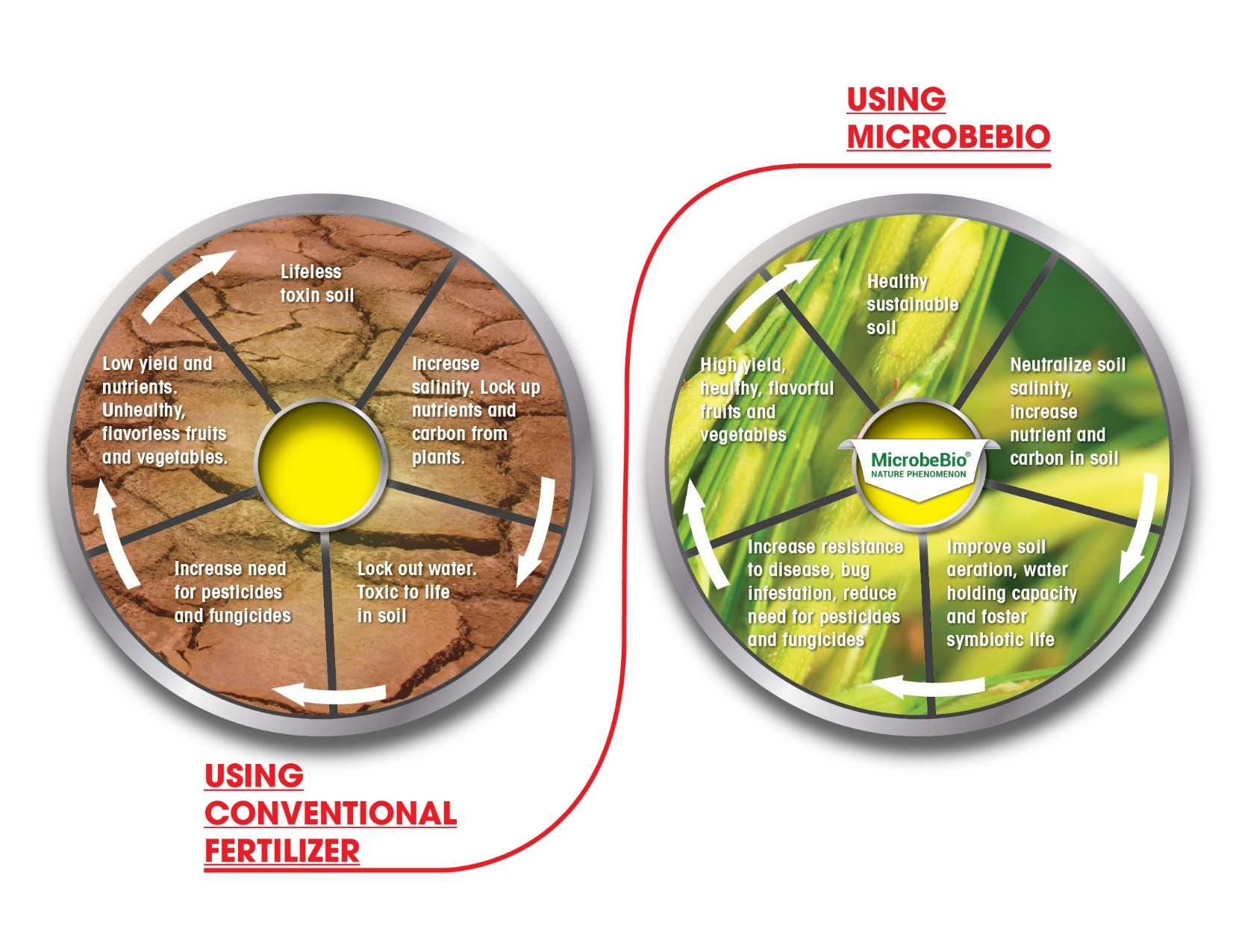
TRANSPLANT METHOD + PRODUCTS SUMMARY
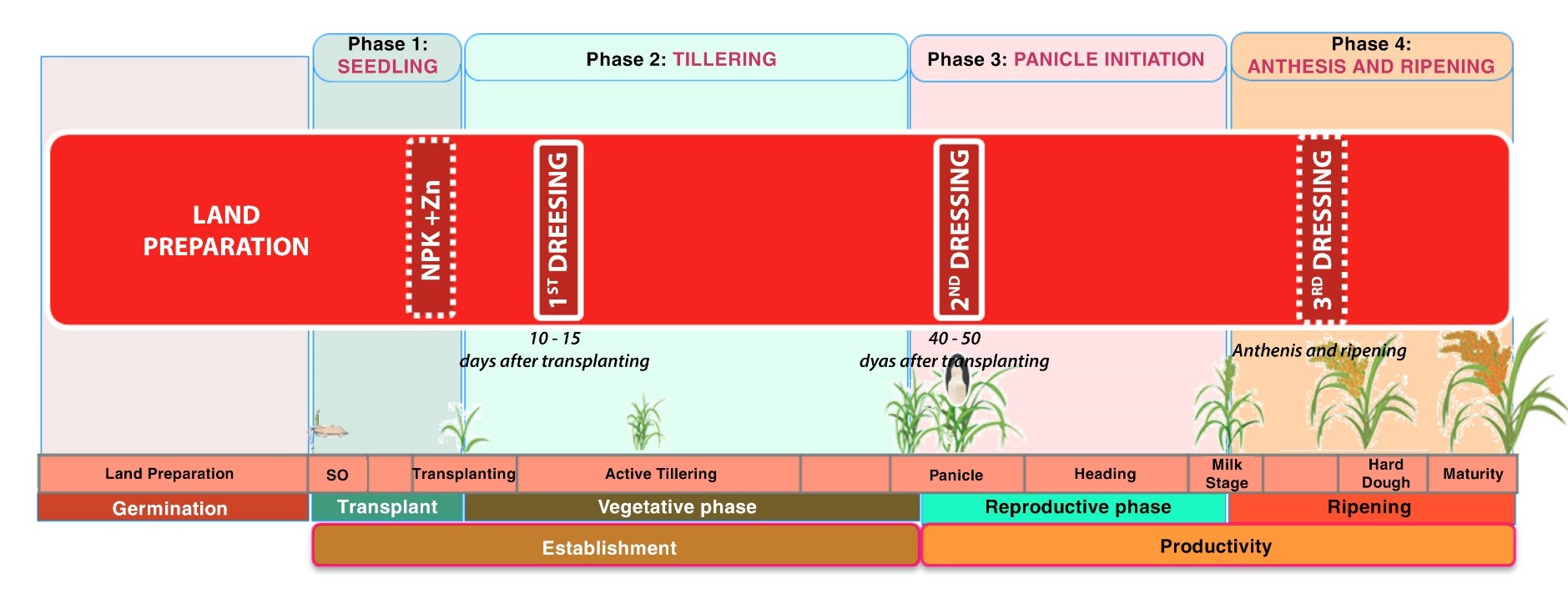
| PRODUCTS | GERMINATION AND 1ST DAY | 1ST DRESSING | 2ND DRESSING | 3RD DRESSING |
| MICROBEBIO® NATURE VIGOR™ | Apply 100g to dip root
Apply 1.9 kg to treat 1 hectare |
Apply 2 kg to treat 1 hectare | Apply 2 kg to treat 1 hectare | |
| MICROBEBIO® HYDRO ACTIVATOR™ | Apply 4 liters to treat 1 hectare | Apply 2 liters to treat 1 hectare | Apply 4 liters to treat 1 hectare | Optional |
| MICROBEBIO® RHIZO ACTIVATOR™ | Apply 50 kg to treat 1 hectare
(slow-release nutrients are enough for a whole season.) |
Optional |
